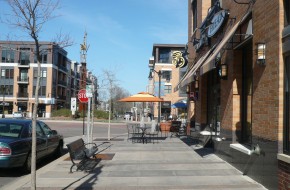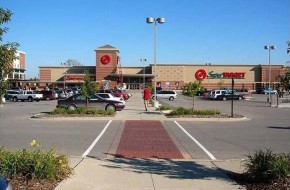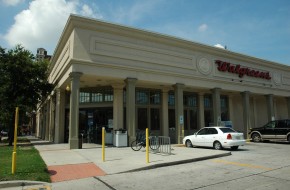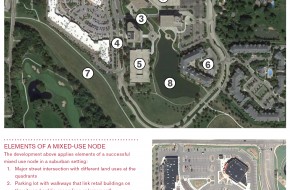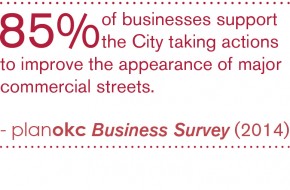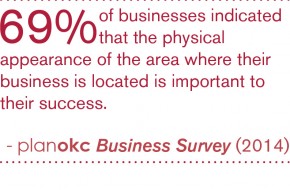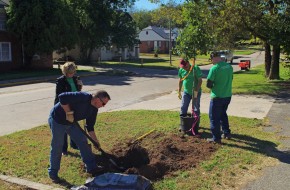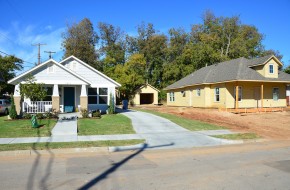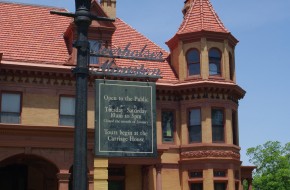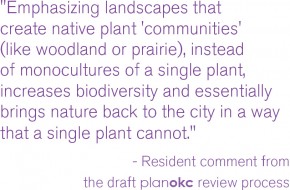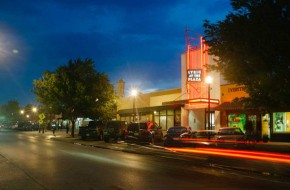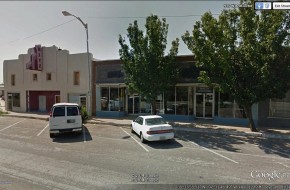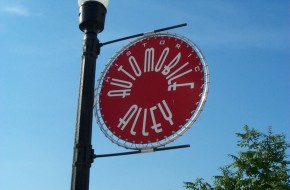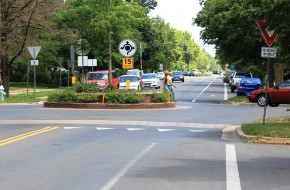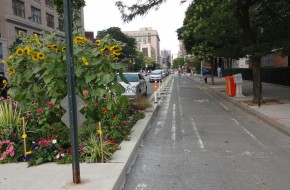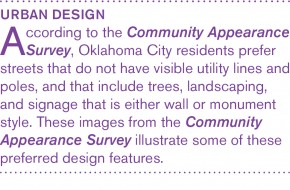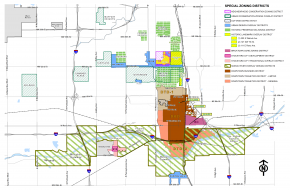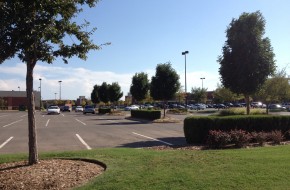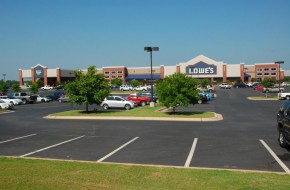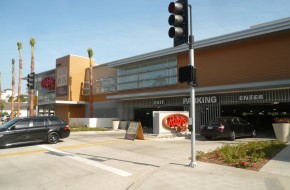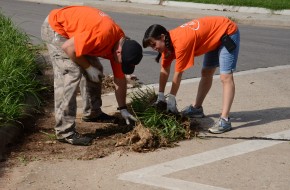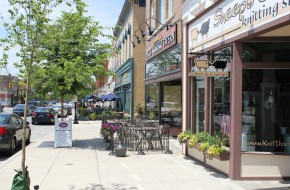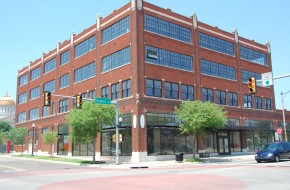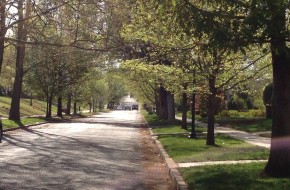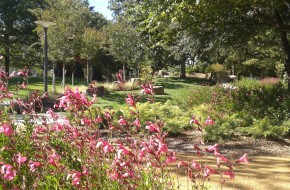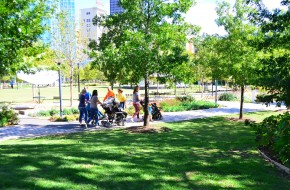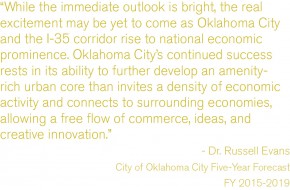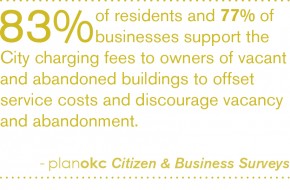The initiatives below relate to community appearance. Click on any initiative to view a full explanation and related policies.
We will build housing and neighborhoods that address the needs of citizens at all stages of their lives. Oklahoma City's citizens and their households have characteristics such as family size, income, age, and tastes that require diverse housing choices. In the past, the majority of new housing development has been single-family, detached, and owner-occupied on relatively large lots. We have also tended to separate housing by type and cost, encouraged by our zoning and subdivision ordinances. However, the private market and resident needs are moving toward greater diversification – different designs, densities, and prices, connected together into neighborhoods. Most housing is built privately, and builders, who respond to markets, cannot be forced to build certain kinds of products. City decisions should encourage both diversity and integration of housing types to the maximum degree possible. Implementing the LUTA concept will help remove statutory obstacles to projects that include diverse housing types and relate them to each other. Updated subdivision regulations will also require the street, pedestrian, and bicycle connectivity, common space, and housing variety needed to turn "pods" into communities.
Design standards can establish a baseline for quality development that respects the needs for both privacy and civic life, and incentives should reward builders and developers who innovate to build diverse, active communities.
Click to expand policy information.
Maximize the use of all appropriate state, federal, local, and private funding for the development, preservation, and rehabilitation of housing affordable to a variety of income groups, including those that integrate low-income housing units in otherwise market-rate housing developments and support the creation and/or expansion of mixed-income communities.
Integrate housing rehabilitation programs with neighborhood revitalization programs. These programs should include assistance to property owners to renovate the existing housing stock with improvements that reduce utility and maintenance costs for owners and occupants, conserve energy, conserve water, and reduce greenhouse gas emissions.
Create and/or enhance Community Development Corporations (CDCs) and Community Housing Development Organizations (CHDOs) to increase their capacity to provide mixed-income housing, especially in targeted infill areas.
Prevent concentration of low-income populations by providing housing opportunities for all income groups in targeted redevelopment areas of the city with a particular focus on mixed-income projects, especially on those projects that have a public funding component.
Create regulations/standards/guidelines that focus on design and/or compatibility principles which are sensitive to the surrounding urban form, especially in areas that are stable or improving and whose character is well-established. These provisions should also help ensure compatibility between lower- and higher- intensity land uses.
In conjunction with City regulatory changes, such as significant modifications to zoning ordinances, building codes, or subdivision regulations, assess the effects of the proposed modifications on housing development costs and overall housing affordability, considering the balance between housing affordability and other objectives such as environmental quality, urban design quality, maintenance of neighborhood character and protection of public health, safety and welfare. This assessment should be integrated into the code amendment process, identify barriers to housing affordability, and include recommended mitigation.
Increase the viability of townhomes and condominiums as housing products by:
- Adopting and supporting new local and state laws to increase consumer protection for condos and townhomes (e.g., better funding mechanisms and maintenance enforcement for common areas).
- Requiring developers to demonstrate sustainable funding levels for common area and facility maintenance costs.
Support diversity and integration of housing unit types and sizes in all land use typology areas in order to meet the diverse needs of households of different sizes, generational needs, incomes, and preferences. New residential subdivisions should achieve a mixture of housing types within a unified development.
Avoid concentrations of apartment complexes. Instead, integrate multifamily units into neighborhoods with mixes of housing types or in mixed-use developments.
Amend the zoning ordinance to better accommodate the integration of various residential densities, building types, and styles.
Create design standards and guidelines for the design, materials, shared amenities, and accessibility of high density urban residential development. Standards and guidelines should promote privacy and livability in a high density, mixed-use environment.
Evaluate existing regulations for effectiveness in promoting density and mixed-use development and in addressing surface parking. Develop a new urban design code for downtown and other key districts to promote healthy mixes of land uses that are compatible and complementary.
Adopt subdivision regulations that ensure new neighborhoods meet the basic needs of residents while supporting an efficient development pattern. Regulations should cover:
- Open space (passive and active),
- Demonstration of sustainable funding levels for common area and facility maintenance costs,
- Walkability and bikeability,
- Internal and external street connectivity,
- Block length,
- Integration of uses,
- Integration of a variety of home sizes,
- Integration of a variety of unit types, and
- Preservation of Environmentally Sensitive Areas.
Regulations could be based on a point scale to allow flexibility, while still requiring basic minimum thresholds be met.
New regulations should remove the existing requirement for development in Rural LUTAs to connect to water and sewer systems and establish a minimum one-acre lot size for lots with on-site sewer treatment.
We will establish and execute design guidelines for new commercial projects that enhance appearance, access, and function, and strengthen their surrounding neighborhoods. It seems to many people that one specific priority seems to drive commercial design: getting cars as quickly as possible from the street to parking lots. This produces a common pattern of buildings (shopping centers, multi-tenant strips, free-standing structures) separated from the streets and surrounded by parking, with big signs located along the road for maximum visibility from cars. In fact, zoning and development codes generally focus much more on parking than on the uses and buildings that the parking serves. This generic approach, repeated everywhere, lacks innovation, reduces the customer experience to finding a place to park, and produces inefficient and unattractive commercial strips. However, some new commercial designs are successfully following other approaches, based on providing a good customer experience. Our commercial development standards should also move in this direction. They should guide projects in ways that serve the competitive interests of neighborhoods, developers, businesses, and the entire community.
These guidelines should not micromanage development but instead should follow a few fundamental principles:
- Organizing commercial development as districts to the maximum degree possible. "Districts" allow customers to accomplish several purposes with one trip, to park once and walk comfortably and safely from business to business, and to find features and public amenities that encourage personal interaction and a positive customer experience.
- Engaging commercial buildings and businesses with public streets and sidewalks rather than their parking lots.
- Relating commercial development to surrounding residential neighborhoods, encouraging direct and convenient local access without inviting outside traffic.
- Incorporating mixed land uses such as higher-density residential, services, and offices into commercial projects.
- Developing well-conceived signs and graphics that communicate and guide customers without excessive size and numbers.
- Using site features like landscaping, walkways, internal driveways, and drainage areas to make projects more attractive, secure, and easier for customers to use.
- Reducing the amount of surface area devoted to parking, or dividing parking lots into smaller blocks for circulation and orientation.
We will focus commercial development in nodes that have good transportation access and support the development of multiple uses. Commercial strip development disperses business, working against the creation of walkable, multi-purpose activity centers. Yet, commercial zoning is often granted along these corridors by default, as people assume that their appearance, traffic, and previous land use patterns make them unsuitable for other uses. Nodes are more conducive than strips to pedestrian, bicycle, and transit access and encourage public spaces that upgrade the customer experience. planokc can reshape the character of major corridors, making them good environments for multiple uses. They will also direct commercial development to nodes that provide both good transportation access and opportunities for retailers to reinforce each other. Nodes at intersections may adopt a mixed-use character when non-retail uses are incorporated into at least one quadrant of an intersection.
Click to expand policy information.
Establish regulations that require pedestrian connections between new commercial development and adjoining residential areas.
Share parking among contiguous developments.
Undertake targeted parking studies to determine existing parking capacity and develop appropriate parking standards based on land use, location, and demand.
Initiate new efforts to reduce sign clutter and improve the aesthetics of signs, while allowing for adequate and visible business identification by the following potential measures:
- Restrict new billboards and eliminate or reduce the number of existing billboards.
- Require non-conforming signs to be removed or be brought into compliance with existing regulations within a specific timeframe.
- Consider new standards in the Sign Ordinance to improve limits on the size, height, and number of signs.
- Improve proactive enforcement of the City’s sign regulations to curtail the placement of illegal signs and ensure adequate maintenance of signs.
Develop and adopt new standards/guidelines that result in improvements to parking structure design including the following potential measures:
- Design parking structures to be architecturally integrated with adjoining primary structure(s).
- Include integrated storefronts or other active uses on the ground floors of parking structures that are adjacent to public sidewalks and other pedestrian plazas.
- Enhanced exterior façades of structures by integrating architectural features and materials that complement the character of the surrounding area, or screening with vegetation.
Improve parking provisions in neighborhoods that are near vibrant commercial corridors/areas by improving parking and corridor design, non-vehicular networks, transit, and signage.
Strengthen existing businesses and business districts within and adjacent to established residential areas. Promote the development of new businesses to provide additional jobs and higher income opportunities for nearby residents.
Favor commercial development clustered in nodes at arterial or collector intersections or along brief “main street” style corridors over commercial development extending in a linear pattern for long distances along highway, arterial, or collector corridors.
Regional-, community-, and neighborhood-scale retail developments should provide an internal vehicle and pedestrian circulation system between new and existing centers and individual stores that draws on the following principles:
- Concentrate access for new retail development at shared primary entrance points. Primary entrance points should be aligned with access points immediately across intersecting roads. Limit curb cuts on primary highways and arterials.
- Provide pedestrian circulation, including sidewalks and median breaks along interior and exterior fronting roads and within parking lots.
- Encourage coordinated development of retail centers in order to facilitate internal pedestrian and vehicle circulation and optimal center performance.
Commercial buildings should be built at the street rather than behind a parking lot in order to promote pedestrian circulation, multipurpose shopping trips, and walkable and attractive streetscapes. Large-scale commercial buildings with parking in front should screen parking lots with the coordinated development of out-parcels (pad sites) and with landscaping.
Amend the landscape ordinance to increase the number of trees and landscaped islands required in parking lots.
New neighborhood-scale retail should be located within new residential growth areas to serve daily shopping needs and limit trip distances. In newly developing areas, this retail format is preferred to the existing linear development patterns along arterials.
Neighborhood-scale retail should be developed at the median breaks or intersections of major or minor connectors.
Wayfinding mechanisms and other placemaking features should be strongly encouraged in new and existing commercial districts.
Encourage unified planning for all adjoining land owned or controlled by a project’s developer to ensure proper circulation and land use relationships.
Evaluate existing regulations for effectiveness in promoting density and mixed-use development and in addressing surface parking. Develop a new urban design code for downtown and other key districts to promote healthy mixes of land uses that are compatible and complementary.
We will establish an urban forestry program, directed by a city forester, to manage and improve the city’s tree canopy. This program's primary function will be to preserve and manage the existing tree canopy, increase the area with tree cover, and ensure that new projects utilize landscape materials appropriate to Oklahoma City’s climate and environment. This will be accomplished by:
- Monitoring and managing the City's "urban forest," the trees on public lands and right-of-ways;
- Providing technical assistance and advice to private residents, businesses, and property owners; and
- Developing enforceable standards and incentives through preparation of an Urban Landscape Guide and revision of the existing landscape ordinance. Ordinance revisions should improve landscape requirements and provide both requirements and incentives for tree preservation in new projects.
Click to expand policy information.
Establish incentives such as a simplified permitting process, reduced application fees, and special recognition for projects that:
- Utilize best management practices or other low-impact development methods for storm water management.
- Bring buried streams to the surface and restore riparian habitat.
- Install bridge systems instead of culverts for stream crossings to help maintain the natural ecosystem associated with the stream.
Revise development regulations to require the following factors to be addressed in development and redevelopment proposals:
- Preservation of existing natural resources, such as wooded areas, habitat areas, and floodplains.
- Utilization of natural treatments and methods to stabilize or rehabilitate stream and river banks as a means to preserve downstream habitats.
- Integration of a variety of native or compatible non-native, non-invasive plant species.
- Mitigation of impacts of development on habitat, wildlife corridors, riparian and littoral areas, and water quality, through actions such as restoration or re-vegetation of disturbed natural areas and replacement of trees/habitat on-site or off-site.
- Management of invasive plant and animal species.
- Management and maintenance of natural areas, common areas and drainage areas.
- Impact on surface and groundwater supply.
- Impact on water quality caused by land uses and activities.
- Impacts on floodplains, riparian and littoral areas and wetlands and areas with significant landforms.
Develop a manual of best management practices that can be integrated into City codes. These include, but are not limited to:
- Tree care and management.
- Tree planting.
- Tree protection.
- Street trees (location, conflicts, maintenance, etc. – in addition to general tree care guidelines).
- Placement of utilities (e.g., under streets vs. under park strips)
- Low impact development techniques.
- Habitat protection and restoration.
- Conservation easements and/or subdivisions.
Establish an Urban Forestry Program and City Urban Forester position to achieve the following:
- Measure and monitor tree canopy coverage and habitat on a regular basis so that any policies, programs, and regulations may be adjusted accordingly as situations change. Establish a process to maintain current data.
- Develop and maintain regulations, policies, processes, and programs that focus on protection and preservation of native trees.
- Provide assistance with proper tree selection, location, and maintenance to prevent power outages, reduce property damage, and coordinate emergency response during natural disaster events (excessive snow and ice, tornadoes, etc.), address the urban heat island effect, and reduce energy costs, etc.
- Establish programs such as tree give-aways, neighborhood planting programs, and education workshops.
- Provide resources to the public about tree selection, management, and care.
- Seek grant funding for community tree planting to improve City parks, publicly maintained rights-of-way and other areas of the city.
- Inventory the City’s street trees and develop a tree replacement program.
- Partner with volunteer and nonprofit organizations to recruit volunteers for tree planting and maintenance and to coordinate community-wide tree planting efforts.
Develop and adopt a tree preservation ordinance that achieves the following:
- Defines methods of preservation;
- Defines situations where preservation of trees is mandatory versus optional;
- Establishes incentives for tree preservation;
- Establishes mitigation options if preservation cannot be accomplished; and
- Establishes penalties for unauthorized tree removal.
Preserve mature healthy trees and incorporate them into the design of new development or redevelopment projects to the greatest extent possible. Include provisions and best management practices to ensure proper tree protection throughout the construction process. Best management practices include but are not limited to:
- The use of proper pruning techniques;
- Appropriate watering;
- Installation of protective fencing at the drip lines of trees or groups of trees;
- Designated material storage areas; and
- Approved equipment and vehicle parking and maintenance areas.
Provide the public with resources, tools, and guidance to deal with environmental hazards, such as:
- Information about safe disposal options for household contaminants such as motor oils, paints, computers, televisions, batteries, etc.
- Information on environmental hazards, such as brownfield sites.
- Information about funds available to assist with environmental cleanups.
Pursue methods to reduce the impact of the urban heat island effect on Oklahoma City by:
- Establishing a minimum canopy coverage requirement over paved surfaces such as parking lots.
- Instating a “continuous canopy” requirement for new streets and street reconstruction projects.
- Promoting the use of building and roofing materials that reduce heat island effects.
Establish development regulations that help improve air quality, including:
- Specifying construction controls that reduce airborne dust;
- Increasing landscaping and tree planting to absorb carbon dioxide and air pollutants; and
- Encouraging development patterns and densities that support alternative modes of transportation in the urban LUTAs.
Preserve overall landscape character and natural landforms (rolling hills, native vegetation, etc.) to the greatest extent possible.
Protect and preserve natural resources, by:
- Identifying and mapping valuable natural resources, such as, native prairies.
- Maintaining a comprehensive inventory and assessment of natural resources and critical habitats.
- Identifying opportunities to create an interconnected green infrastructure network throughout and beyond Oklahoma City’s municipal boundaries via existing trail and greenway projects, parks, stream corridors, and natural areas.
- Seeking the voluntary sale of land or dedication of conservation easements on private land that is identified as critical habitat or is necessary to link wildlife corridors.
- Pursuing protection of strategically identified natural areas by placing them in conservation easements or land banks, and reserving them for future use as open space and passive recreational areas.
- Managing invasive plant and animal species.
- Partnering with applicable State agencies and non-profit entities.
Identify and protect critical habitats for state and federally listed threatened or endangered species.
Identify migratory birds and their nesting sites prior to construction. Protect migratory birds and their nesting sites throughout the construction process and refrain from construction near nesting sites until migratory birds are no longer actively nesting and have moved on from the site. Verify compliance with Migratory Bird Treaty Act.
We will set neighborhood development priorities by using quantitative evaluation criteria. Available resources are never sufficient to address the problems of struggling neighborhoods. Setting priorities and policy focuses can be addressed by an evaluative process that considers such factors as economic opportunities, educational performance, housing quality, access to commercial and other support services, public safety, and presence of community organizations and institutions. The process should consider positive neighborhood factors that can create the foundations for success, including:
- Existing support capacity from neighborhood associations, local service providers, and area businesses;
- Community institutions like parks, schools, churches, or community centers; and,
- Connections to surrounding neighborhoods.
We will expand rehabilitation and redevelopment programs to stabilize the physical fabric of neighborhoods. The physical condition of a neighborhood and its buildings is critical to its ability to function as a community. Residential rehabilitation programs should be expanded to both meet the needs of existing residents and serve future generations. Rehabilitation should focus items that directly affect health and safety, secure the basic building envelope, and add economic value to the surrounding area. Programs in which community development corporations acquire, rehabilitate, and either sell or rent units on a "turnkey" basis at moderate costs have been particularly effective in adding value, preserving housing, and introducing new owners and potential leaders into a neighborhood.
But housing rehabilitation is only part of the picture. Vacant sites and dilapidated buildings depress both property values and community momentum. Programs to accelerate the redevelopment of dilapidated properties should be tied closely to the priority evaluation process. Funds should be targeted to areas and projects that create a critical mass that in turn catalyzes private market investment and creates a self-sustaining community. Mechanisms like landbanks and land trusts have also proven effective in gaining control over vacant properties and returning them to productive use. Often, a high priority or visibility project at a strategic location can produce an unexpectedly powerful private reaction as neighbors gain confidence in their future.
We will create, enhance, and maintain community spaces where residents interact positively and advance the social fabric. Successful neighborhoods include spaces where people see and greet each other, and work and play together in a common enterprise. These spaces open a neighborhood, and increase the level of positive interaction that is the essence of a living neighborhood. Yet, hidden or neglected public spaces have the opposite effect, attracting nuisances and sometimes crime, and being scary or off-putting places that people avoid. Good community spaces can take many forms – a well-maintained public park surrounded and watched over by residents; a community garden; the median of a parkway; or a school or community center site.
Strengthening these community places begins with inventorying and analyzing their operations. This can be done in cooperation with neighbors and community organizations. Volunteer work, business participation, and other public and private support can provide the means to reclaim existing spaces and develop new ones, and to provide adequate resources for continued support and maintenance.
Facilities like community gardens and groceries are particularly attractive as community spaces because they are self-supporting; become natural and productive attractors of people, and address other key concerns such as access to healthy food. Efforts at a neighborhood level to secure sites and organize gardens should be expanded and educational institutions should provide technical help to gardeners. Public development incentives should have a special focus on attracting grocery stores to skipped over areas with viable consumer markets, and should encourage inclusion of public space in project design.
We will coordinate public infrastructure projects and community revitalization. In an effort to create tangible catalysts for revitalizing urban communities, the City will use the analysis described in this section as well as those located throughout planokc, to inform its capital improvements program.
Click to expand policy information.
Reverse the detrimental impact of vacant and abandoned buildings through the following efforts:
- Develop an Abandoned Buildings program geared toward a significant reduction in vacancies by creating incentives and/or penalties that discourage prolonged building abandonment and help the City to recoup the costs associated with vacated buildings. Use fees generated by this program to help fund redevelopment of abandoned buildings.
- Assess the feasibility of potential reuse options for dilapidated or abandoned buildings. Define and establish criteria to help identify buildings that are too far gone and/or too costly to feasibly rehabilitate, and consider a coordinated demolition program for those buildings.
- Seek changes in state legislation to enhance the City’s ability to maintain and improve its neighborhoods including:
- Laws which would speed up the demolition process for long-term dilapidated or abandoned properties that cannot be rehabilitated, and
- Laws which would strengthen the City’s ability to require property owners to rehabilitate or sell neglected, boarded-up properties.
Modify codes and/or regulations to create opportunities for more income diversity and mixed-income neighborhoods by allowing a variety of housing ownership and leasing arrangements, diverse housing sizes and types – including accessory dwelling units, carriage homes, lofts, live-work spaces, cottages, and manufactured/modular housing. Modifications should allow an increase the variety of ownership opportunities to include condominiums, ownership cooperatives (such as mutual housing associations, limited equity cooperatives, etc.) by identifying and removing regulatory barriers. Recommend improvements to protections for owners, developers, and lenders.
Priority should be given to projects that achieve efficiencies described elsewhere in planokc, such as dwelling units that are located to have easy access to each other and to other daily needs including jobs, recreation, and schools.
Maximize the use of all appropriate state, federal, local, and private funding for the development, preservation, and rehabilitation of housing affordable to a variety of income groups, including those that integrate low-income housing units in otherwise market-rate housing developments and support the creation and/or expansion of mixed-income communities.
Prioritize neighborhoods for revitalization and re-investment in order to reverse the decline associated with poor maintenance of public infrastructure and other property by using the following objective criteria:
- Low economic opportunity;
- Low educational attainment;
- Poor health outcomes;
- Poor housing environments;
- Low neighborhood quality; and,
- Existing capacity to support the revitalization efforts; and other important indicators.
Increase the City’s capacity to participate in targeted programs that strengthen neighborhood infrastructure and other assets.
Increase and/or re-assign City staff to support targeted neighborhoods and coalitions.
Integrate housing rehabilitation programs with neighborhood revitalization programs. These programs should include assistance to property owners to renovate the existing housing stock with improvements that reduce utility and maintenance costs for owners and occupants, conserve energy, conserve water, and reduce greenhouse gas emissions.
Identify, evaluate, and mitigate challenges associated with neighborhoods where housing values are rising quickly in response to public investment.
Establish new or expand existing financing methods and/or mechanisms available to new and redevelopment mixed-income projects in urban areas. These could include: direct investment of public housing funds, tax-increment financing, bonds, revolving loans, housing program funds and/or other proven public-private partnership models.
Create and/or enhance Community Development Corporations (CDCs) and Community Housing Development Organizations (CHDOs) to increase their capacity to provide mixed-income housing, especially in targeted infill areas.
Reuse brownfield, greyfield, and other vacant building sites to provide new opportunities for mixed-used and mixed-income housing.
Catalyze the rehabilitation of abandoned structures by amending codes to facilitate the adaptive reuse of existing buildings for residential use.
Develop a City program to rehabilitate or redevelop dilapidated properties, including a land bank to receive donated properties from property owners who can no longer maintain their properties.
Prevent concentration of low-income populations by providing housing opportunities for all income groups in targeted redevelopment areas of the city with a particular focus on mixed-income projects, especially on those projects that have a public funding component.
Create places and opportunities for neighborhood events that allow neighbors to interact.
Add legislative priorities for state laws to:
- Strengthen the City’s ability to obtain specific performance of property owners cited for code violations.
- Speed up the demolition process for long-time boarded properties that cannot be rehabilitated.
- Strengthen the City’s ability to require property owners to rehabilitate or sell neglected, boarded-up properties.
- Expedite the clearing of properties involved in probate.
Strengthen existing businesses and business districts within and adjacent to established residential areas. Promote the development of new businesses to provide additional jobs and higher income opportunities for nearby residents.
Strategically use subsidized housing programs along with other City services and programs to revitalize targeted areas of the city.
Quickly repair damage caused by vandalism, including graffiti, to minimize negative impacts on neighborhoods. Coordinate the efforts of existing programs, such as the Police Department’s Removal Unit, the Public Works Department’s Removal Unit, and Oklahoma County’s “SHINE” program to increase responses in targeted areas and expand the area which can be covered. Increase participation by the business community, such as donations of paint and time.
Establish a working partnership between the City, Oklahoma City Public Schools, Putnam City Schools, Western Heights Schools, and other metro area school districts and educational entities to help school districts complete a variety of non-educational (or indirectly educational) functions such as planning for and siting new schools, working on shared use issues, and redeveloping closed schools. The partnership should coordinate efforts to seek funding and appropriate resources to accomplish the following:
- Establish multiuse recreational and exercise facilities in schoolyards to increase opportunities for physical activity and strengthen the relationship between schools and neighborhoods.
- Establish a program to increase the number of community members and schools that make effective use of Senate Bill 1882 (effective 11/1/2012) allowing shared use of school facilities for recreational purposes.
Study the impact of vacant parcels on places and special districts, and determine how best to mitigate any negative impacts.
Rather than rely solely on federal CDBG funding, seek other sources to continue to support the Strong Neighborhoods Initiative and Neighborhood Stabilization Program in order to enhance their ability to reverse decline and create valuable places.
Create and implement small area plans for neighborhoods or districts with special strategic importance or complications related to development or redevelopment.
Encourage redevelopment and infill development on vacant, underutilized, and brownfield sites in urbanized areas.
Catalyze infill development on vacant, underutilized, and brownfield sites in urbanized areas by:
- Investing in infrastructure improvements;
- Improving multi-modal transportation networks;
- Improving parks and open spaces;
- Improving schools and other civic resources;
- Exploring innovative methods such as:
- A public-private partnership to purchase problem properties in target areas and build or rehabilitate homes while improving infrastructure and amenities
- An infill house plan program similar to Sacramento or Milwaukee
- Identifying and removing barriers to rehabilitation and/or replacement of residential buildings.
- Establishing a position in the City to facilitate medium- and large-scale redevelopment projects through the development process by guiding interactions with City departments, allied agencies, and utility companies.
Encourage the adaptive reuse of underutilized structures and the revitalization of older, economically distressed neighborhoods.
Prioritize maintaining the strength of existing commercial nodes and corridors over providing new areas for commercial development.
Continue promoting the re-use, redevelopment, and revitalization of low-performing or declining commercial areas.
Support diversity and integration of housing unit types and sizes in all land use typology areas in order to meet the diverse needs of households of different sizes, generational needs, incomes, and preferences. New residential subdivisions should achieve a mixture of housing types within a unified development.
We will institute neighborhood design guidelines and practices that build community in lower-density settings. We recognize that different people have different preferences. Many people seek new houses but still want the diversity and neighborliness of the best of established neighborhoods. Others seek the bigger lots and greater personal space offered by low-density development. But almost everyone wants an attractive living environment, a sense of belonging to a community, public space, and connection. As we move toward new standards that implement the land use plan, we should ensure that new development designs reflect patterns that create better communities. These include such items as encouraging lot clusters to maintain open space, even in low-density development; street connections for both community contact and public safety access; trail and pathway systems; and housing variety where appropriate. Planned unit developments should be used in their intended way, to encourage creative design by looking at developments in their entirety.
Click to expand policy information.
Revise subdivision regulations to include connectivity standards and guidelines that require greater street connectivity, and provide allowances for pedestrian and bicycle connections when street connectivity cannot be made.
Establish regulations that require pedestrian connections between new commercial development and adjoining residential areas.
Change subdivision regulations to determine the number of entries into a residential development based on number of lots in order to improve connectivity of the roadway network and emergency response.
Establish a process for existing neighborhoods to request traffic calming, including how to evaluate the request, select the appropriate type of calming treatment, and fund recommendations.
Require sidewalks on both sides of all streets in urban LUTAs and in the Rural Residential LUTA for subdivisions with densities greater than 1 unit per acre.
Develop and adopt new standards/guidelines to promote new residential subdivision designs that orient residential neighborhoods toward adjacent complementary uses or features such as parks, schools, open space, and neighborhood serving commercial sites, promoting improved direct accessibility and more seamless community integration.
Define responsibilities and assurances for maintaining, repairing, or replacing community walls and fences. Consider creating programs for routine and consistent maintenance of fencing along arterial roadways that could include fencing assessment districts, long-term bonds, or assigned HOA maintenance of community fencing.
Create regulations/standards/guidelines that focus on design and/or compatibility principles which are sensitive to the surrounding urban form, especially in areas that are stable or improving and whose character is well-established. These provisions should also help ensure compatibility between lower- and higher- intensity land uses.
Create places and opportunities for neighborhood events that allow neighbors to interact.
Strengthen existing businesses and business districts within and adjacent to established residential areas. Promote the development of new businesses to provide additional jobs and higher income opportunities for nearby residents.
Use established mechanisms/tools to allow property owners to provide for the perpetual maintenance, repair and reconstruction of private roads, sidewalks, trails, utilities, and parks in new housing developments by requiring funding mechanisms such as:
- Maintenance bonds/escrows
- Special assessment districts, such as Business Improvement District or Special Improvement District
- Covenants requiring compulsory membership in an incorporated Property Owners Association whose members will be financially liable for any such maintenance, repair, or reconstruction costs.
Incorporate these financing options into the platting process (or zoning process in the case of PUDs).
Construct all private roads and utilities to comply with minimum design and paving standards as outlined in the City of Oklahoma City Subdivision Regulations, including those related to the appropriate Street Typology.
Modify codes to allow residential clustering in rural land use typology areas, provided water supply and sewage disposal requirements are met, and permanently preserve nearby open space through means such as conservation easements.
Maximize fire safety through actions such as:
Modifying regulations and guidelines to prevent subdivisions with a single point of access – except those with fewer than 10 homes.
Developing a vegetation management program targeting the wildland/urban interface, including rights-of-way in rural areas, and incorporating recommendations from the National Fire Protection Association’s Firewise Communities initiative.
Requiring residential sprinklers for developments located in Rural Land Use Typologies.
Requiring exceptional, effective, and easy access to sites augmented by a thorough system of connections within and between developments.
Adopt new citywide site design and building regulations that ensure new developments meet basic functional and aesthetic minimums related to:
- Walkability and bike-ability
- Internal and external street connectivity
- Integration of uses
- Signage
- Building location
- Building appearance
- Open space (passive and active)
Encourage the integration of different land uses in urban areas through the following means:
- Promote the use of performance standards in place of existing zoning methods (which address incompatibility by separating uses). Performance-based regulations should focus on achieving compatibility between uses by addressing the following:
- Noise, odors and air quality
- Traffic and parking (allow flexible, but sufficient parking)
- Site layout and building design
- Waste
- Safety
- Lighting (glare control, placement, and shielding)
- Delivery hours
- Enhance transit service (bus and rail).
- Prevent large areas of concentration of any particular land use such as multi-family or commercial.
Amend the zoning ordinance to better accommodate the integration of various residential densities, building types, and styles.
Adopt subdivision regulations that ensure new neighborhoods meet the basic needs of residents while supporting an efficient development pattern. Regulations should cover:
- Open space (passive and active),
- Demonstration of sustainable funding levels for common area and facility maintenance costs,
- Walkability and bikeability,
- Internal and external street connectivity,
- Block length,
- Integration of uses,
- Integration of a variety of home sizes,
- Integration of a variety of unit types, and
- Preservation of Environmentally Sensitive Areas.
Regulations could be based on a point scale to allow flexibility, while still requiring basic minimum thresholds be met.
New regulations should remove the existing requirement for development in Rural LUTAs to connect to water and sewer systems and establish a minimum one-acre lot size for lots with on-site sewer treatment.
We will develop a comprehensive strategy for the identification, retention, preservation, and revitalization of the city's historic, cultural, and architectural resources. Oklahoma City has nine locally designated historic districts, and four locally designated individual landmarks. Additionally, the city has many other historic and architectural resources, including nearly 100 properties and over two-dozen districts listed on the National Register of Historic Places, and many more potential local or National Register districts and landmarks. We need to improve our understanding of the extent and condition of our existing historic resources and consider the state of current practice and the impact of current development patterns, existing policies, and regulations on those resources. A comprehensive historic preservation plan will identify future preservation and rehabilitation focuses, and establish the basis for new and improved policies, review guidelines, and incentives to conserve our spectrum of historic assets in the built environment.
A historic preservation plan also has another significant function: increasing public awareness and knowledge of preservation and its role in community development. Educational programs should address three objectives:
- Increasing community understanding on the role of preservation and support for specific programs.
- Increasing knowledge and competence of property owners as they work on historic properties.
- Educating owners and developers on the process, potential markets, and available incentives for preservation projects.
We will create targeted incentives for preservation processes, aimed at potential obstacles. The historic preservation plan will recommend new tools to help deliver real projects. Some of these tools may include low-interest or forgivable loans, Tax Increment Financing, historic tax credits, preservation easements (the first of which was recently accepted), and expedited review processes. These strategies should focus on two general areas: financing gaps created by some of the contingencies of historically appropriate preservation and adaptive reuse, and concerns by developers about delays or uncertainties during the project development process.
We will revise and adopt new ordinances that ensure consistency in the review of projects that affect historic properties. All historic preservation programs involve the review of projects. Every case is different, and the review process must deal with difficult issues such as economic feasibility, level of deterioration, impact of change or even loss of a building on a neighborhood. Establishing consistency in this process ensures a strong program.
Click to expand policy information.
Maintain the traditional grid street pattern where it currently exists, reconnect it where possible, and keep alleys open and functioning. When improving older streets in neighborhoods, maintain original street widths and curb radii.
Maintain historical lot and block sizes where possible and appropriate.
Develop and adopt a city-wide Historic Preservation Plan to comprehensively address the identification, retention, preservation, and revitalization of the City’s historic, cultural, archeological, and architectural resources. The plan could be used to accomplish the following:
- Consolidate existing documentation on the City’s historic resources, including historic surveys, reports and studies, and existing local, state, and national designations in order to identify areas of recognized significance and areas that are under-/undocumented. Use this information to set priorities for additional research.
- Evaluate the impact of current development patterns, existing policies, and regulations on City-wide historic resources, and adopt new policies, guidelines, or ordinance amendments as necessary to address weaknesses, inconsistencies, and regulatory or financial disincentives for preservation.
- Identify buildings, sites, or districts for potential new Historic Preservation and Historic Landmark zoning, Legacy Resource designation, or for eligibility to take advantage of other tools including National Register nomination and related tax credits, preservation easements, and others.
- Develop policies, regulations, and guidelines for a City-wide review of all work impacting historic resources including, but not limited to, treatment of dilapidated or vacant and abandoned buildings, review of demolitions proposed outside of HP/HL designated areas, and review of the impact that new development has on historic resources located outside the City core.
Establish new incentives and raise awareness of existing incentives that stimulate the preservation and rehabilitation of historic resources. Incentives could include:
- Preservation easements, low-interest or forgivable rehabilitation loans, and Tax Increment Financing Districts for historic buildings, sites, and districts.
- Tools and practices for public/private partnerships to ensure the preservation and retention of top-priority historic resources whose deterioration or demolition would present an irreparable and highly significant loss to the City and beyond.
- Existing city, state, and federal tools and incentives for rehabilitation, including state and federal tax credits for certified rehabilitation.
- Expedited review process for projects involving infill sites.
Protect the unique character of National Register-listed properties or districts and local Historic Districts and ensure that development and redevelopment is compatible with historic resources and character.
Revise ordinances for design districts and design review procedures to ensure consistency in the treatment of historic properties, including the assessment of demolition proposals, the identification of historic or significant properties, and the consideration of the impact that the alteration or demolition of individual properties has on the context and continuity of the surrounding environment.
Coordinate with civic and professional organizations and relevant advocacy groups to:
- Develop improved programming and content that educates the public, key professionals, and city leaders about the economic and environmental benefits of historic preservation and adaptive reuse, including facts about retrofitting historic buildings to meet modern living and energy needs, costs of rehabilitation, and ways for older buildings to comply with accessibility and other code requirements.
- Develop resources for owners of historic properties, including hands-on training clinics or demonstration projects, a guidebook providing before-and-after examples of reused buildings in Oklahoma City, outreach and free assistance with the design review process, and a clearinghouse of information and design, labor, and materials resources for preservation, restoration, and revitalization.
Establish policy or adopt ordinance language to ensure that City-owned or controlled historic buildings are appropriately recognized, maintained and repaired, or rehabilitated. Potential methods to be considered could include:
- Attach a preservation restriction or easement to historic properties that are surplused by the City.
- Assess the historic status of City-owned or controlled properties in order to follow through with formal HP/HL zoning, National Register listing, or other historic designation as appropriate.
- Incorporate early and substantive review of city improvement projects to assess potential impacts on historic buildings, and adopt alternatives that minimize or eliminate the impacts when necessary.
We will update and improve the city's landscape ordinances. Improvements will address the objectives of improving community appearance, minimizing land use incompatibilities, improving air quality, and managing the city's micro-climate. These ordinances also must address the long-term by including maintenance in their requirements. This starts with requiring native trees and plants that are adapted to the central Oklahoma climate. Use of native and drought tolerant plants lowers irrigation requirements, lowers cost, and conserves water.
We will educate the public on the use of native materials and proper maintenance. Preconceived notions of an aesthetically pleasing landscape often lead to the use of high-maintenance materials like non-native grasses. To overcome these inclinations, educational materials, demonstration gardens, and targeted corridor improvement projects should advertise both the beauty and benefits of proper installation and maintenance of native landscapes.
We will develop better procedures for reporting, citing and enforcement of violations. The current system for enforcement of landscaping requirements is complaint based, resulting in inconsistent maintenance on private properties and along many public rights-of-way. Improved procedures for code enforcement affecting private properties and additional funding sources for public areas should establish a clear level of expectation across the city.
Click to expand policy information.
Routinely assess the City’s development standards, design guidelines, and development review procedures to ensure that they reflect current trends in best-practice and allow for innovative design techniques and evolving methods in low-impact development.
Enhance existing development standards and establish design guidelines for areas outside of the City’s existing Design Review Overlay Districts. Development standards and design guidelines could include the following provisions:
- Minimize views and prominence of parking lots in relation to structures on a site.
- Sense of proportion (street width to building height, human scale)
- Pedestrian orientation of structures and architectural detailing/fenestration
- Terminated vistas
- Reduce the predominance of residential garages in the design of the front facades of single-family residences.
- Inclusion of front porches into the design of residential structures.
- Internal orientation of parking facilities and garages in multi-family developments.
- Improved pedestrian safety and enhanced pedestrian access through parking lots.
Develop distinctive standards for different types and categories of walls and fences, emphasizing durability, aesthetics, and visual continuity in materials and design with particular consideration of zoning classification.
Initiate new efforts to reduce sign clutter and improve the aesthetics of signs, while allowing for adequate and visible business identification by the following potential measures:
- Restrict new billboards and eliminate or reduce the number of existing billboards.
- Require non-conforming signs to be removed or be brought into compliance with existing regulations within a specific timeframe.
- Consider new standards in the Sign Ordinance to improve limits on the size, height, and number of signs.
- Improve proactive enforcement of the City’s sign regulations to curtail the placement of illegal signs and ensure adequate maintenance of signs.
Incorporate natural features (such as ponds, lakes, streams, rock outcroppings, stands of mature trees, and/or sizable individual trees) into the design of all residential, commercial, and industrial projects rather than eliminating, hiding, or limiting access to those features.
Establish streetscape standards requiring attractive entry features and the provision of accessible common open space in new neighborhoods.
Develop and adopt new standards/guidelines to promote new residential subdivision designs that orient residential neighborhoods toward adjacent complementary uses or features such as parks, schools, open space, and neighborhood serving commercial sites, promoting improved direct accessibility and more seamless community integration.
Develop and adopt new standards to minimize the detrimental appearance of accessory utility equipment (i.e. transformers, cable cabinets, telephone cabinets, utility meters, valves, etc.) by integrating them into less prominent areas of the site design or by screening them with landscaping, artistic features, or architectural materials compatible with the primary structures. If not encouraged, artistic embellishment (creating urban ambiance with imaginatively designed/painted screens) should not be prohibited. Ensure that such facilities are situated so that they do not impede pedestrian access.
Enhance the City’s Landscape Ordinance by accomplishing the following objectives:
- Add guidelines and recommendations for landscape design that minimizes the need for supplemental irrigation.
- Clarify responsibilities and standards for landscape maintenance, including within public rights-of-way.
- Incentivize the use of drought-tolerant and native plants.
- Restrict the use of turf grass to the greatest extent feasible.
- Evaluate existing landscape standards for parking lots and consider making revisions that would result in more landscape buffering on parking lot fringes and more internal landscaping.
- Evaluate existing landscape standards to determine whether new standards should be adopted to help screen or buffer parking structures.
- Evaluate existing landscape standards in comparison to best practices and peer cities to determine whether minimum site landscaping standards should be revised and/or restructured to result in increased landscaping.
Consider the adoption of improved requirements to screen parked vehicles from view with enhanced landscaping, berming, low screen walls, and existing or proposed buildings, or some combination of those elements.
Establish a funded beautification program and source of funding to provide facade and landscaping enhancements along targeted industrial corridors.
Improve landscape design, installation, and landscape maintenance compliance through the following actions:
- Produce informational materials and work with local media to publicize the benefits of limiting turf areas (e.g. reduced water use, less mowing) and highlight the positive effects on property values and aesthetics that result from proper installation and maintenance of landscaping.
- Develop a program, including informational outreach, to inform property owners of their responsibilities to maintain right-of-way areas, the procedures for enforcement, and the applicable fines.
- Identify specific corridors with the worst landscape maintenance conditions and initiate coordinated clean-up programs in those locations.
- Install demonstration gardens/landscapes in select civic/public locations to provide practical examples of how to integrate drought tolerant and low maintenance plants in commercial and residential installations.
- Improve efficiency and effectiveness of the process for reporting, citing, and proactive enforcement violations for maintenance and compliance with landscape requirements.
- Explore the establishment of landscape improvement/maintenance districts where property owners are assessed a pro-rata share of the costs to properly and uniformly maintain landscaping within the district boundaries.
Develop a Master Streetscape Program to improve the appearance along major arterial streets. The program should outline methods for establishing a uniform streetscape appearance (with distinctive designs for individual streets or classifications of streets) through appropriate tree placement, species, and spacing, and coordinating the location of street trees in proximity to utilities, sidewalks, street lights and structures, and appropriate sidewalk designs. Differentiation in streetscape designs could be designated by street typology, designated areas, or other factors.
Using performance standards related to flow quantity, quality, and pattern, modify development regulations, codes, and policies to support the use of green infrastructure/low impact development techniques to mimic natural systems for developments within aquifer recharge zones with moderate or high vulnerability or in areas where streams and riparian areas have been channelized or developed (primarily in the Downtown, UH, and UM LUTAs). Low impact development techniques include but are not limited to:
- Onsite treating or filtering of stormwater contaminants.
- Discharging run-off as sheet-flow after passing through grassy or vegetated open space areas, rather than discharging run-off through concentrated outfalls.
- Creating attractive open space amenities that double as stormwater detention, retention, and / or filtering systems.
- Utilizing pervious pavement, pavers, or asphalt in appropriate locations (i.e. sidewalks, parking spaces, trails, patios, etc.).
- Utilizing planters (at grade or raised), vegetated landscape strips adjacent to roads and parking areas, and alternative curbing designs (allowing stormwater to easily move from impervious areas to pervious areas), to encourage stormwater infiltration and temporary detention.
- Rain Gardens
- Bioswales
- Green streets and alleys
- Green roofs
- Rooftop collection
- Underground detention
- Increased tree canopy preservation/tree planting
- Land/open space conservation
- Cluster development
Revise development regulations to require the following factors to be addressed in development and redevelopment proposals:
- Preservation of existing natural resources, such as wooded areas, habitat areas, and floodplains.
- Utilization of natural treatments and methods to stabilize or rehabilitate stream and river banks as a means to preserve downstream habitats.
- Integration of a variety of native or compatible non-native, non-invasive plant species.
- Mitigation of impacts of development on habitat, wildlife corridors, riparian and littoral areas, and water quality, through actions such as restoration or re-vegetation of disturbed natural areas and replacement of trees/habitat on-site or off-site.
- Management of invasive plant and animal species.
- Management and maintenance of natural areas, common areas and drainage areas.
- Impact on surface and groundwater supply.
- Impact on water quality caused by land uses and activities.
- Impacts on floodplains, riparian and littoral areas and wetlands and areas with significant landforms.
Revise the landscape ordinance to include the following:
- Define terms such as invasive species, exotic/non-native species, and native/indigenous species
- Require removal of invasive species from existing sites, and prohibit such species from being planted or maintained in new development.
- Provide a reference list of native plants and drought-tolerant plants.
- Provide incentives for using native and drought-tolerant plants and disincentives for using high-water plants and turf grass.
- Establish requirements for using design practices that minimize the need for supplemental irrigation.
Preserve natural habitat, maintain wildlife food sources, and reduce the risk of propagating invasive plant species by utilizing vegetation native to Oklahoma, preferably central Oklahoma, for all mitigation and habitat restoration efforts associated with new development and redevelopment projects, public and private, to the greatest extent possible.
Establish an Urban Forestry Program and City Urban Forester position to achieve the following:
- Measure and monitor tree canopy coverage and habitat on a regular basis so that any policies, programs, and regulations may be adjusted accordingly as situations change. Establish a process to maintain current data.
- Develop and maintain regulations, policies, processes, and programs that focus on protection and preservation of native trees.
- Provide assistance with proper tree selection, location, and maintenance to prevent power outages, reduce property damage, and coordinate emergency response during natural disaster events (excessive snow and ice, tornadoes, etc.), address the urban heat island effect, and reduce energy costs, etc.
- Establish programs such as tree give-aways, neighborhood planting programs, and education workshops.
- Provide resources to the public about tree selection, management, and care.
- Seek grant funding for community tree planting to improve City parks, publicly maintained rights-of-way and other areas of the city.
- Inventory the City’s street trees and develop a tree replacement program.
- Partner with volunteer and nonprofit organizations to recruit volunteers for tree planting and maintenance and to coordinate community-wide tree planting efforts.
Develop and adopt a tree preservation ordinance that achieves the following:
- Defines methods of preservation;
- Defines situations where preservation of trees is mandatory versus optional;
- Establishes incentives for tree preservation;
- Establishes mitigation options if preservation cannot be accomplished; and
- Establishes penalties for unauthorized tree removal.
Pursue methods to reduce the impact of the urban heat island effect on Oklahoma City by:
- Establishing a minimum canopy coverage requirement over paved surfaces such as parking lots.
- Instating a “continuous canopy” requirement for new streets and street reconstruction projects.
- Promoting the use of building and roofing materials that reduce heat island effects.
Modify development and subdivision regulations, and City policies to minimize alteration of natural landforms and native vegetation and maximize retention of distinctive natural features for public and private projects.
Establish development regulations that help improve air quality, including:
- Specifying construction controls that reduce airborne dust;
- Increasing landscaping and tree planting to absorb carbon dioxide and air pollutants; and
- Encouraging development patterns and densities that support alternative modes of transportation in the urban LUTAs.
We will reinforce the city's existing cultural districts and expand the network into new areas. The city's cultural districts have specific zoning and urban design regulations. They are "experience centers" that strengthen their surrounding neighborhoods. This program should be enhanced in two ways:
- Reinforcing existing districts through small-scale public realm projects (identifying graphics, sidewalk and streetscape improvements, wayfinding); cross-marketing; and integration into an "active loop," linking the nodes with pedestrian and bicycle routes.
- Expanding the program to new cultural districts, including the four pending districts and others that might be identified through the historic preservation plan and other neighborhood planning processes.
Ultimately, the culture districts should be viewed as, and evolve, into a connected network of attractions.
Click to expand policy information.
Ensure that public art is integrated into the planning and implementation for key initiatives such as Core to Shore, Project 180, MAPS 3 and other City projects as well as downtown, neighborhoods, cultural districts, and commercial districts.
Make it easier for arts and cultural projects to navigate the City’s design review, zoning, licensing, and permit processes.
Provide a centralized area(s) for artists to live and work (e.g. Paseo, Film Row) by targeting districts within the city that have become centers for all types (performing, visual, literary, etc.) of art.
Coordinate efforts to educate the public regarding the location of all public art installations and potential locations for future installations. Such efforts could include:
- Producing educational materials for each newly commissioned work in the City’s Public Art collection and making these available to the publiC.
- Providing educational materials detailing the locations of public art installations, such as walking tour guides, podcasts, physical markers, or web-based maps.
- Developing and adopting a Physical Master Plan to promote public art “districts” for key areas, including the Riverfront, downtown, the airport.
- Establishing a collection management system for public art to catalogue artist, location, condition, value and other details of public interest.
Identify the economic value of cultural resources in attracting tourism and reinvest a share of tourism revenue to sustain and expand these resources.
Showcase local talent by incorporating the work of artists into City activities such as wall displays, public information efforts, and special events.
Explore the implementation of the following efforts to increase the economic impact of cultural activities and arts programs:
- Efforts organized by Oklahoma City Office of Arts and Cultural Affairs:
- Formalize neighborhood-based cultural economic development plans
- Work with groups interested in establishing a vacant storefronts program with artists
- Establish a public art program to include local artists
- Coordinate a master list of artist opportunities
- Convene organizers of events and festivals to share knowledge and resources
- Coordinate use of publicly-owned space for use by artists.
- Efforts coordinated by Cultural Development Corporation of Central OK (CDCOK):
- Clarify roles among arts service entities
- Expand business skills training for artists
- Build capacity among nonprofits for fiscal/project sponsorship
- Strengthen partnerships and engagement with higher education resources
- Provide artist fellowships in partnership with philanthropies
- Evolve CDCOK into an economic development entity
- Efforts led by artists:
- Build a multi-disciplinary artist network
- Conduct an Annual Artist Summit
- Pilot art sales program based on the Community Supported Art model
- Recognize outstanding contributions by artists to the region
Use light fixtures and street furniture in the public right-of-way that complement established or evolving cultural or design districts.
Create a public outreach program designed to explain and promote the benefits of urban design principles and design review districts.
Develop and adopt a Cultural Heritage Plan with the objective of reviving, explaining, commemorating, and integrating the City’s cultural history through its cultural districts, landmarks, and facilities. The plan could be used to accomplish the following:
- Develop a cultural map of the City identifying the location of all cultural resources, landmarks, and cultural districts. Convert this information into maps and guides for residents and visitors so they may visit Oklahoma City’s cultural and historic sites using their preferred transportation method (walking tours, bike tours, river tours, transit routes, driving routes, etc.).
- Develop an effective and attractive cultural signage program, including kiosk type directories in pedestrian areas, coordinated and designed to direct residents and visitors to major art and cultural sites or districts in the City. The program may also include such items as markers and temporary seasonal or event-based banners.
- Examine opportunities to maintain and expand existing art and cultural facilities and to attract new ones. Coordinate a cultural needs assessment to determine future space needs, cultural variety potential, and potential sites to accommodate improvements.
- Protect and facilitate the enhancement of existing and emerging arts and cultural districts throughout the City to preserve the unique character of these diverse neighborhoods.
- Assess the accessibility of the City’s art and cultural facilities and resources to determine if improvements are necessary. Recommend ways to enhance access and linkages to art and cultural facilities and resources via new sidewalks, trails, and pedestrian amenities and/or expanded transit service.
Establish a program to develop place-making capacity in the city. The program should promote the economic and quality-of-life benefits of place-making investments and should:
- Establish and maintain partnerships between the City, the private sector, and “place management” organizations.
- Provide funding and City staff support for “place management” organizations.
Create specialized districts for large cultural or ethnic groups to enhance the diversity and perceptions of the city. Identify appropriate areas and create master plans with urban design guidelines specialized to the cultural history on display. For example, one special district could be themed for the Hispanic/Latino community. Such a district would include associated thematic infrastructure, amenity, design, public art, and streetscape improvements.
We will update and enhance design standards and guidelines that apply to areas outside existing Design Review Districts. The Community Appearance Survey identified residents' support for pedestrian-oriented amenities and human-scaled development. Appealing living spaces combine ingredients such as street and sidewalk environments, properly scaled buildings, visual interest, well-placed and designed furniture, and other elements. Updated standards will address the lessons and results of the Community Appearance Survey and provide practical and cost-effective design guidance and choices. They will address scale, materials, variety, visual quality, signs and graphics, and environmental sensitivity. The effort to update and enhance these standards will involve all stakeholders. They will also be routinely reviewed against best practices, allowing innovative design techniques and incorporating new techniques in low-impact development.
We will remove obstacles to greater design variety within residential construction. Community Appearance Survey participants strongly supported residential designs that included front porches and minimized garage exposure. These findings and the Housing Demand Study results both indicated interest in smaller lots and greater housing product variety, especially among younger households. Both the sustainokc and liveokc elements speak to the need for more diverse housing types. Design guidelines should illustrate ways to achieve higher densities in configurations that are consistent with citizen preferences. In addition, city standards and regulations that discourage design features like rear-loaded garages or mixed density housing should be modified.
We will improve regulation of sign scale, number, and placement. Sign images were the lowest rated urban design element in the Community Appearance Survey. New sign regulations will be fashioned as part of land development ordinance revisions to reduce clutter and increase legibility. Code direction will include limits on the number of permitted signs, increased use of ground signs, location standards, better overall size limitations, and requirements for sign master plans for large projects.
We will develop a Great Streets Program to improve the appearance of major arterial streets. Oklahoma City has implemented a Downtown Streetscape Master Plan, and should extend the concept of cohesive standards for landscaping, lighting, street furniture, sidewalk and crosswalk design, utility placement and treatment, and other elements to other streets of civic importance. This effort is related to the street typology concept presented in Chapter Two. The master planning effort will identify corridors of visual significance and establish vocabularies of materials and treatments that will be applied during widenings or reconstruction projects or on a stand-alone basis.
Click to expand policy information.
Routinely assess the City’s development standards, design guidelines, and development review procedures to ensure that they reflect current trends in best-practice and allow for innovative design techniques and evolving methods in low-impact development.
Enhance existing development standards and establish design guidelines for areas outside of the City’s existing Design Review Overlay Districts. Development standards and design guidelines could include the following provisions:
- Minimize views and prominence of parking lots in relation to structures on a site.
- Sense of proportion (street width to building height, human scale)
- Pedestrian orientation of structures and architectural detailing/fenestration
- Terminated vistas
- Reduce the predominance of residential garages in the design of the front facades of single-family residences.
- Inclusion of front porches into the design of residential structures.
- Internal orientation of parking facilities and garages in multi-family developments.
- Improved pedestrian safety and enhanced pedestrian access through parking lots.
Establish a list of preferred and discouraged building materials for all zoning districts.
Develop distinctive standards for different types and categories of walls and fences, emphasizing durability, aesthetics, and visual continuity in materials and design with particular consideration of zoning classification.
Initiate new efforts to reduce sign clutter and improve the aesthetics of signs, while allowing for adequate and visible business identification by the following potential measures:
- Restrict new billboards and eliminate or reduce the number of existing billboards.
- Require non-conforming signs to be removed or be brought into compliance with existing regulations within a specific timeframe.
- Consider new standards in the Sign Ordinance to improve limits on the size, height, and number of signs.
- Improve proactive enforcement of the City’s sign regulations to curtail the placement of illegal signs and ensure adequate maintenance of signs.
Make it easier for arts and cultural projects to navigate the City’s design review, zoning, licensing, and permit processes.
Establish new incentives and raise awareness of existing incentives that stimulate the preservation and rehabilitation of historic resources. Incentives could include:
- Preservation easements, low-interest or forgivable rehabilitation loans, and Tax Increment Financing Districts for historic buildings, sites, and districts.
- Tools and practices for public/private partnerships to ensure the preservation and retention of top-priority historic resources whose deterioration or demolition would present an irreparable and highly significant loss to the City and beyond.
- Existing city, state, and federal tools and incentives for rehabilitation, including state and federal tax credits for certified rehabilitation.
- Expedited review process for projects involving infill sites.
Develop and implement a Comprehensive Public Art Master Plan to:
- Establish goals and a framework for the rational development of a public art program for Oklahoma City
- Integrate public art into each of the City’s key development initiatives and community sectors with a plan for both permanent and temporary placement processes that facilitate new public art coordination and investment.
- Create an administrative and financial structure (with roles and responsibilities) to efficiently and effectively facilitate multi-departmental and multi-agency public art partnerships.
- Evaluate the current development/design/art review processes and make recommendations for improved and streamlined public art policies and procedures for both permanent and temporary public art (including murals).
- Involve the community in the process of public art selection to build consensus for the program.
- Include an educational component to reinforce the value of public art in the public realm for all ages and cultures.
- Provide a plan for maintaining the value and physical integrity of the City’s public art collection.
Allow the reuse of vacant storefronts as exhibition space for local artists.
Protect the unique character of National Register-listed properties or districts and local Historic Districts and ensure that development and redevelopment is compatible with historic resources and character.
Revise ordinances for design districts and design review procedures to ensure consistency in the treatment of historic properties, including the assessment of demolition proposals, the identification of historic or significant properties, and the consideration of the impact that the alteration or demolition of individual properties has on the context and continuity of the surrounding environment.
Provide incentives for private development projects that include public art.
Incorporate natural features (such as ponds, lakes, streams, rock outcroppings, stands of mature trees, and/or sizable individual trees) into the design of all residential, commercial, and industrial projects rather than eliminating, hiding, or limiting access to those features.
Establish streetscape standards requiring attractive entry features and the provision of accessible common open space in new neighborhoods.
Develop and adopt new standards/guidelines to promote new residential subdivision designs that orient residential neighborhoods toward adjacent complementary uses or features such as parks, schools, open space, and neighborhood serving commercial sites, promoting improved direct accessibility and more seamless community integration.
Develop and adopt new standards to minimize the detrimental appearance of accessory utility equipment (i.e. transformers, cable cabinets, telephone cabinets, utility meters, valves, etc.) by integrating them into less prominent areas of the site design or by screening them with landscaping, artistic features, or architectural materials compatible with the primary structures. If not encouraged, artistic embellishment (creating urban ambiance with imaginatively designed/painted screens) should not be prohibited. Ensure that such facilities are situated so that they do not impede pedestrian access.
Facilitate and coordinate burial of overhead power and communications distribution lines.
Enhance the City’s Landscape Ordinance by accomplishing the following objectives:
- Add guidelines and recommendations for landscape design that minimizes the need for supplemental irrigation.
- Clarify responsibilities and standards for landscape maintenance, including within public rights-of-way.
- Incentivize the use of drought-tolerant and native plants.
- Restrict the use of turf grass to the greatest extent feasible.
- Evaluate existing landscape standards for parking lots and consider making revisions that would result in more landscape buffering on parking lot fringes and more internal landscaping.
- Evaluate existing landscape standards to determine whether new standards should be adopted to help screen or buffer parking structures.
- Evaluate existing landscape standards in comparison to best practices and peer cities to determine whether minimum site landscaping standards should be revised and/or restructured to result in increased landscaping.
Develop and adopt new standards/guidelines that result in improvements to parking structure design including the following potential measures:
- Design parking structures to be architecturally integrated with adjoining primary structure(s).
- Include integrated storefronts or other active uses on the ground floors of parking structures that are adjacent to public sidewalks and other pedestrian plazas.
- Enhanced exterior façades of structures by integrating architectural features and materials that complement the character of the surrounding area, or screening with vegetation.
Develop standards/guidelines that require architectural articulation, variety, and interest on large structures adjacent to public streets by limiting long stretches of unbroken wall planes.
Define responsibilities and assurances for maintaining, repairing, or replacing community walls and fences. Consider creating programs for routine and consistent maintenance of fencing along arterial roadways that could include fencing assessment districts, long-term bonds, or assigned HOA maintenance of community fencing.
Consider the adoption of improved requirements to screen parked vehicles from view with enhanced landscaping, berming, low screen walls, and existing or proposed buildings, or some combination of those elements.
Use light fixtures and street furniture in the public right-of-way that complement established or evolving cultural or design districts.
Create a public outreach program designed to explain and promote the benefits of urban design principles and design review districts.
Develop a Master Streetscape Program to improve the appearance along major arterial streets. The program should outline methods for establishing a uniform streetscape appearance (with distinctive designs for individual streets or classifications of streets) through appropriate tree placement, species, and spacing, and coordinating the location of street trees in proximity to utilities, sidewalks, street lights and structures, and appropriate sidewalk designs. Differentiation in streetscape designs could be designated by street typology, designated areas, or other factors.
Establish development standards and design guidelines for new cultural, civic, and sporting facilities that address site design, architecture, compatibility, pedestrian-orientation and access, landscaping, and the inclusion of public art.
Using performance standards related to flow quantity, quality, and pattern, modify development regulations, codes, and policies to support the use of green infrastructure/low impact development techniques to mimic natural systems for developments within aquifer recharge zones with moderate or high vulnerability or in areas where streams and riparian areas have been channelized or developed (primarily in the Downtown, UH, and UM LUTAs). Low impact development techniques include but are not limited to:
- Onsite treating or filtering of stormwater contaminants.
- Discharging run-off as sheet-flow after passing through grassy or vegetated open space areas, rather than discharging run-off through concentrated outfalls.
- Creating attractive open space amenities that double as stormwater detention, retention, and / or filtering systems.
- Utilizing pervious pavement, pavers, or asphalt in appropriate locations (i.e. sidewalks, parking spaces, trails, patios, etc.).
- Utilizing planters (at grade or raised), vegetated landscape strips adjacent to roads and parking areas, and alternative curbing designs (allowing stormwater to easily move from impervious areas to pervious areas), to encourage stormwater infiltration and temporary detention.
- Rain Gardens
- Bioswales
- Green streets and alleys
- Green roofs
- Rooftop collection
- Underground detention
- Increased tree canopy preservation/tree planting
- Land/open space conservation
- Cluster development
Revise development regulations to require the following factors to be addressed in development and redevelopment proposals:
- Preservation of existing natural resources, such as wooded areas, habitat areas, and floodplains.
- Utilization of natural treatments and methods to stabilize or rehabilitate stream and river banks as a means to preserve downstream habitats.
- Integration of a variety of native or compatible non-native, non-invasive plant species.
- Mitigation of impacts of development on habitat, wildlife corridors, riparian and littoral areas, and water quality, through actions such as restoration or re-vegetation of disturbed natural areas and replacement of trees/habitat on-site or off-site.
- Management of invasive plant and animal species.
- Management and maintenance of natural areas, common areas and drainage areas.
- Impact on surface and groundwater supply.
- Impact on water quality caused by land uses and activities.
- Impacts on floodplains, riparian and littoral areas and wetlands and areas with significant landforms.
Revise the landscape ordinance to include the following:
- Define terms such as invasive species, exotic/non-native species, and native/indigenous species
- Require removal of invasive species from existing sites, and prohibit such species from being planted or maintained in new development.
- Provide a reference list of native plants and drought-tolerant plants.
- Provide incentives for using native and drought-tolerant plants and disincentives for using high-water plants and turf grass.
- Establish requirements for using design practices that minimize the need for supplemental irrigation.
Establish an Urban Forestry Program and City Urban Forester position to achieve the following:
- Measure and monitor tree canopy coverage and habitat on a regular basis so that any policies, programs, and regulations may be adjusted accordingly as situations change. Establish a process to maintain current data.
- Develop and maintain regulations, policies, processes, and programs that focus on protection and preservation of native trees.
- Provide assistance with proper tree selection, location, and maintenance to prevent power outages, reduce property damage, and coordinate emergency response during natural disaster events (excessive snow and ice, tornadoes, etc.), address the urban heat island effect, and reduce energy costs, etc.
- Establish programs such as tree give-aways, neighborhood planting programs, and education workshops.
- Provide resources to the public about tree selection, management, and care.
- Seek grant funding for community tree planting to improve City parks, publicly maintained rights-of-way and other areas of the city.
- Inventory the City’s street trees and develop a tree replacement program.
- Partner with volunteer and nonprofit organizations to recruit volunteers for tree planting and maintenance and to coordinate community-wide tree planting efforts.
Pursue methods to reduce the impact of the urban heat island effect on Oklahoma City by:
- Establishing a minimum canopy coverage requirement over paved surfaces such as parking lots.
- Instating a “continuous canopy” requirement for new streets and street reconstruction projects.
- Promoting the use of building and roofing materials that reduce heat island effects.
Modify development and subdivision regulations, and City policies to minimize alteration of natural landforms and native vegetation and maximize retention of distinctive natural features for public and private projects.
Modify codes and/or regulations to create opportunities for more income diversity and mixed-income neighborhoods by allowing a variety of housing ownership and leasing arrangements, diverse housing sizes and types – including accessory dwelling units, carriage homes, lofts, live-work spaces, cottages, and manufactured/modular housing. Modifications should allow an increase the variety of ownership opportunities to include condominiums, ownership cooperatives (such as mutual housing associations, limited equity cooperatives, etc.) by identifying and removing regulatory barriers. Recommend improvements to protections for owners, developers, and lenders.
Priority should be given to projects that achieve efficiencies described elsewhere in planokc, such as dwelling units that are located to have easy access to each other and to other daily needs including jobs, recreation, and schools.
Ensure that new publicly financed developments – those which directly use or receive public dollars – with more than 100 units or with densities greater than 10 units/acre are located where they have easy access to frequent transit service.
Establish a program or series of programs that significantly improve the quality, appearance, and perception of rental housing throughout the city. Program components should include: 1) owner, manager, and tenant education; 2) code enforcement and inspections; 3) design standards/considerations that promote safety; 4) high attention to property maintenance; and 5) other relevant best practices.
Establish new or expand existing financing methods and/or mechanisms available to new and redevelopment mixed-income projects in urban areas. These could include: direct investment of public housing funds, tax-increment financing, bonds, revolving loans, housing program funds and/or other proven public-private partnership models.
Create regulations/standards/guidelines that focus on design and/or compatibility principles which are sensitive to the surrounding urban form, especially in areas that are stable or improving and whose character is well-established. These provisions should also help ensure compatibility between lower- and higher- intensity land uses.
In conjunction with City regulatory changes, such as significant modifications to zoning ordinances, building codes, or subdivision regulations, assess the effects of the proposed modifications on housing development costs and overall housing affordability, considering the balance between housing affordability and other objectives such as environmental quality, urban design quality, maintenance of neighborhood character and protection of public health, safety and welfare. This assessment should be integrated into the code amendment process, identify barriers to housing affordability, and include recommended mitigation.
Use established mechanisms/tools to allow property owners to provide for the perpetual maintenance, repair and reconstruction of private roads, sidewalks, trails, utilities, and parks in new housing developments by requiring funding mechanisms such as:
- Maintenance bonds/escrows
- Special assessment districts, such as Business Improvement District or Special Improvement District
- Covenants requiring compulsory membership in an incorporated Property Owners Association whose members will be financially liable for any such maintenance, repair, or reconstruction costs.
Incorporate these financing options into the platting process (or zoning process in the case of PUDs).
Construct all private roads and utilities to comply with minimum design and paving standards as outlined in the City of Oklahoma City Subdivision Regulations, including those related to the appropriate Street Typology.
Adopt design standards applicable to both new and remodeled libraries focusing on integrating the building and the site into existing neighborhoods and urban fabric, reducing their dependence on automobiles and increasing their access by other modes, especially walking, biking, and transit.
Maximize fire safety through actions such as:
Modifying regulations and guidelines to prevent subdivisions with a single point of access – except those with fewer than 10 homes.
Developing a vegetation management program targeting the wildland/urban interface, including rights-of-way in rural areas, and incorporating recommendations from the National Fire Protection Association’s Firewise Communities initiative.
Requiring residential sprinklers for developments located in Rural Land Use Typologies.
Requiring exceptional, effective, and easy access to sites augmented by a thorough system of connections within and between developments.
Adopt design standards to enable emergency management resources to be highly effective, such as resilient buildings, interconnected transportation networks, and other design considerations that help ensure community safety and recovery.
Adopt new citywide site design and building regulations that ensure new developments meet basic functional and aesthetic minimums related to:
- Walkability and bike-ability
- Internal and external street connectivity
- Integration of uses
- Signage
- Building location
- Building appearance
- Open space (passive and active)
Require all new utility lines to be buried and bury existing utility lines when possible (e.g., when roads are widened).
Mitigate negative impacts of compactness by:
- Updating nuisance code to better address noise, smell, vibration, property maintenance, panhandling, animal control, delivery hours limits, and other possible negative effects.
- Updating the sign ordinance to reduce visual clutter.
In order to promote compatibility between different uses, establish standards and guidelines that ensure all developments are pedestrian-friendly and human scale at street frontages and property lines.
Develop design standards and guidelines for industrial development. Standards and guidelines should address: sensitive design and placement of buildings; screening or prohibiting outdoor storage; parcel sizes which allow for long term expansion for individual users; special landscaping requirements addressing screening and landscaping adjacent to residential areas and along highway and arterial streets; standards for the suitable location, orientation and screening of loading bays; and buffering treatments for truck access points.
Create design standards and guidelines for the design, materials, shared amenities, and accessibility of high density urban residential development. Standards and guidelines should promote privacy and livability in a high density, mixed-use environment.
Evaluate existing regulations for effectiveness in promoting density and mixed-use development and in addressing surface parking. Develop a new urban design code for downtown and other key districts to promote healthy mixes of land uses that are compatible and complementary.
Adopt subdivision regulations that ensure new neighborhoods meet the basic needs of residents while supporting an efficient development pattern. Regulations should cover:
- Open space (passive and active),
- Demonstration of sustainable funding levels for common area and facility maintenance costs,
- Walkability and bikeability,
- Internal and external street connectivity,
- Block length,
- Integration of uses,
- Integration of a variety of home sizes,
- Integration of a variety of unit types, and
- Preservation of Environmentally Sensitive Areas.
Regulations could be based on a point scale to allow flexibility, while still requiring basic minimum thresholds be met.
New regulations should remove the existing requirement for development in Rural LUTAs to connect to water and sewer systems and establish a minimum one-acre lot size for lots with on-site sewer treatment.
We will increase landscaping and design requirements in parking areas. Tree plantings and landscaping in parking lots have multiple benefits. Trees shade parking areas and decrease the heat island effect, help orient customers in large parking lots, manage circulation, and can be integrated into design elements that provide safe paths for pedestrians. In addition, parking lots should provide safe and pleasant paths from public walks and paths and transit stops to the front door of major projects and destinations. In some cases, parking lots can be designed for multiple purposes, acting as public spaces or markets during specific events. New parking design standards for Oklahoma City should incorporate contemporary practices for improved parking lot design.
We will integrate parking structures into primary structures. In appropriate high intensity settings, parking structures should be used to the maximum degree possible. When located along streets, parking structures should be activated at street level by storefronts, public art, or other details to avoid blank walls. The exterior facades of structures should be enhanced and complement the architectural features and materials of the surrounding area as a means to disguise the function of the structure and to minimize the detrimental aesthetic impacts of such facilities.
Click to expand policy information.
Enhance existing development standards and establish design guidelines for areas outside of the City’s existing Design Review Overlay Districts. Development standards and design guidelines could include the following provisions:
- Minimize views and prominence of parking lots in relation to structures on a site.
- Sense of proportion (street width to building height, human scale)
- Pedestrian orientation of structures and architectural detailing/fenestration
- Terminated vistas
- Reduce the predominance of residential garages in the design of the front facades of single-family residences.
- Inclusion of front porches into the design of residential structures.
- Internal orientation of parking facilities and garages in multi-family developments.
- Improved pedestrian safety and enhanced pedestrian access through parking lots.
Enhance the City’s Landscape Ordinance by accomplishing the following objectives:
- Add guidelines and recommendations for landscape design that minimizes the need for supplemental irrigation.
- Clarify responsibilities and standards for landscape maintenance, including within public rights-of-way.
- Incentivize the use of drought-tolerant and native plants.
- Restrict the use of turf grass to the greatest extent feasible.
- Evaluate existing landscape standards for parking lots and consider making revisions that would result in more landscape buffering on parking lot fringes and more internal landscaping.
- Evaluate existing landscape standards to determine whether new standards should be adopted to help screen or buffer parking structures.
- Evaluate existing landscape standards in comparison to best practices and peer cities to determine whether minimum site landscaping standards should be revised and/or restructured to result in increased landscaping.
Develop and adopt new standards/guidelines that result in improvements to parking structure design including the following potential measures:
- Design parking structures to be architecturally integrated with adjoining primary structure(s).
- Include integrated storefronts or other active uses on the ground floors of parking structures that are adjacent to public sidewalks and other pedestrian plazas.
- Enhanced exterior façades of structures by integrating architectural features and materials that complement the character of the surrounding area, or screening with vegetation.
Consider the adoption of improved requirements to screen parked vehicles from view with enhanced landscaping, berming, low screen walls, and existing or proposed buildings, or some combination of those elements.
Develop a Master Streetscape Program to improve the appearance along major arterial streets. The program should outline methods for establishing a uniform streetscape appearance (with distinctive designs for individual streets or classifications of streets) through appropriate tree placement, species, and spacing, and coordinating the location of street trees in proximity to utilities, sidewalks, street lights and structures, and appropriate sidewalk designs. Differentiation in streetscape designs could be designated by street typology, designated areas, or other factors.
Using performance standards related to flow quantity, quality, and pattern, modify development regulations, codes, and policies to support the use of green infrastructure/low impact development techniques to mimic natural systems for developments within aquifer recharge zones with moderate or high vulnerability or in areas where streams and riparian areas have been channelized or developed (primarily in the Downtown, UH, and UM LUTAs). Low impact development techniques include but are not limited to:
- Onsite treating or filtering of stormwater contaminants.
- Discharging run-off as sheet-flow after passing through grassy or vegetated open space areas, rather than discharging run-off through concentrated outfalls.
- Creating attractive open space amenities that double as stormwater detention, retention, and / or filtering systems.
- Utilizing pervious pavement, pavers, or asphalt in appropriate locations (i.e. sidewalks, parking spaces, trails, patios, etc.).
- Utilizing planters (at grade or raised), vegetated landscape strips adjacent to roads and parking areas, and alternative curbing designs (allowing stormwater to easily move from impervious areas to pervious areas), to encourage stormwater infiltration and temporary detention.
- Rain Gardens
- Bioswales
- Green streets and alleys
- Green roofs
- Rooftop collection
- Underground detention
- Increased tree canopy preservation/tree planting
- Land/open space conservation
- Cluster development
Revise development regulations to require the following factors to be addressed in development and redevelopment proposals:
- Preservation of existing natural resources, such as wooded areas, habitat areas, and floodplains.
- Utilization of natural treatments and methods to stabilize or rehabilitate stream and river banks as a means to preserve downstream habitats.
- Integration of a variety of native or compatible non-native, non-invasive plant species.
- Mitigation of impacts of development on habitat, wildlife corridors, riparian and littoral areas, and water quality, through actions such as restoration or re-vegetation of disturbed natural areas and replacement of trees/habitat on-site or off-site.
- Management of invasive plant and animal species.
- Management and maintenance of natural areas, common areas and drainage areas.
- Impact on surface and groundwater supply.
- Impact on water quality caused by land uses and activities.
- Impacts on floodplains, riparian and littoral areas and wetlands and areas with significant landforms.
Revise the landscape ordinance to include the following:
- Define terms such as invasive species, exotic/non-native species, and native/indigenous species
- Require removal of invasive species from existing sites, and prohibit such species from being planted or maintained in new development.
- Provide a reference list of native plants and drought-tolerant plants.
- Provide incentives for using native and drought-tolerant plants and disincentives for using high-water plants and turf grass.
- Establish requirements for using design practices that minimize the need for supplemental irrigation.
Establish an Urban Forestry Program and City Urban Forester position to achieve the following:
- Measure and monitor tree canopy coverage and habitat on a regular basis so that any policies, programs, and regulations may be adjusted accordingly as situations change. Establish a process to maintain current data.
- Develop and maintain regulations, policies, processes, and programs that focus on protection and preservation of native trees.
- Provide assistance with proper tree selection, location, and maintenance to prevent power outages, reduce property damage, and coordinate emergency response during natural disaster events (excessive snow and ice, tornadoes, etc.), address the urban heat island effect, and reduce energy costs, etc.
- Establish programs such as tree give-aways, neighborhood planting programs, and education workshops.
- Provide resources to the public about tree selection, management, and care.
- Seek grant funding for community tree planting to improve City parks, publicly maintained rights-of-way and other areas of the city.
- Inventory the City’s street trees and develop a tree replacement program.
- Partner with volunteer and nonprofit organizations to recruit volunteers for tree planting and maintenance and to coordinate community-wide tree planting efforts.
Pursue methods to reduce the impact of the urban heat island effect on Oklahoma City by:
- Establishing a minimum canopy coverage requirement over paved surfaces such as parking lots.
- Instating a “continuous canopy” requirement for new streets and street reconstruction projects.
- Promoting the use of building and roofing materials that reduce heat island effects.
Modify development and subdivision regulations, and City policies to minimize alteration of natural landforms and native vegetation and maximize retention of distinctive natural features for public and private projects.
Improve parking provisions in neighborhoods that are near vibrant commercial corridors/areas by improving parking and corridor design, non-vehicular networks, transit, and signage.
Amend the landscape ordinance to increase the number of trees and landscaped islands required in parking lots.
Provide incentives for developers to build parking garages in high density areas. Include design requirements for projects receiving incentives.
We will establish programs for the rehabilitation or redevelopment of deteriorated structures. Vacant and abandoned properties threaten good community appearance. liveokc presents policies that address vacant buildings. When vacant properties have historic or architectural significance, preservation incentives should be especially focused on their reuse.
We will expand efforts to increase public awareness and participation in neighborhood clean-up efforts. These efforts may include training in property maintenance skills, development of volunteer programs (i.e. adopt a street), or publicizing such programs as Bulk Waste Days. Community education programs and materials should increase access to resources and knowledge, and publicize the level of property maintenance expected of citizens of Oklahoma City.
Click to expand policy information.
Enhance existing development standards and establish design guidelines for areas outside of the City’s existing Design Review Overlay Districts. Development standards and design guidelines could include the following provisions:
- Minimize views and prominence of parking lots in relation to structures on a site.
- Sense of proportion (street width to building height, human scale)
- Pedestrian orientation of structures and architectural detailing/fenestration
- Terminated vistas
- Reduce the predominance of residential garages in the design of the front facades of single-family residences.
- Inclusion of front porches into the design of residential structures.
- Internal orientation of parking facilities and garages in multi-family developments.
- Improved pedestrian safety and enhanced pedestrian access through parking lots.
Establish a list of preferred and discouraged building materials for all zoning districts.
Develop distinctive standards for different types and categories of walls and fences, emphasizing durability, aesthetics, and visual continuity in materials and design with particular consideration of zoning classification.
Initiate new efforts to reduce sign clutter and improve the aesthetics of signs, while allowing for adequate and visible business identification by the following potential measures:
- Restrict new billboards and eliminate or reduce the number of existing billboards.
- Require non-conforming signs to be removed or be brought into compliance with existing regulations within a specific timeframe.
- Consider new standards in the Sign Ordinance to improve limits on the size, height, and number of signs.
- Improve proactive enforcement of the City’s sign regulations to curtail the placement of illegal signs and ensure adequate maintenance of signs.
Reverse the detrimental impact of vacant and abandoned buildings through the following efforts:
- Develop an Abandoned Buildings program geared toward a significant reduction in vacancies by creating incentives and/or penalties that discourage prolonged building abandonment and help the City to recoup the costs associated with vacated buildings. Use fees generated by this program to help fund redevelopment of abandoned buildings.
- Assess the feasibility of potential reuse options for dilapidated or abandoned buildings. Define and establish criteria to help identify buildings that are too far gone and/or too costly to feasibly rehabilitate, and consider a coordinated demolition program for those buildings.
- Seek changes in state legislation to enhance the City’s ability to maintain and improve its neighborhoods including:
- Laws which would speed up the demolition process for long-term dilapidated or abandoned properties that cannot be rehabilitated, and
- Laws which would strengthen the City’s ability to require property owners to rehabilitate or sell neglected, boarded-up properties.
Initiate efforts to educate the public regarding programs that provide assistance for neighborhood clean-up efforts. Such efforts could include the following:
- Provide assistance to residents to make housing and neighborhood improvements and provide training in property maintenance skills.
- Develop and organize volunteer programs (such as adopt-a-street, adopt-a-park, and neighborhood clean-up days) and/or coordinate efforts to obtain grant funding to establish community clean-up programs in neighborhoods where inadequate property maintenance is prevalent.
- Publicize Bulk Waste Days and/or explore the possibility of adding more days/increased frequency.
- Develop a list of outside funding sources that could be used for property maintenance and make this information available to all citizens, especially those in targeted low-income areas.
- Establish public educational programs and advertising campaigns to discourage littering. Education should begin at the elementary level and continue through the adult level.
Intensify code enforcement in areas where specific and/or chronic violations have detrimental impacts on community appearance. Such efforts could include:
- Implement stricter enforcement of property maintenance regulations and consider more significant penalties for violations.
- Increase emphasis on the enforcement of littering laws. Impose fines against littering in a uniform and consistent manner to reinforce a public perception that littering does carry a definite risk.
- Immediately report and ensure expedient removal of graffiti that is visible from interstate highways and other important/designated viewshed corridors.
Revise ordinances for design districts and design review procedures to ensure consistency in the treatment of historic properties, including the assessment of demolition proposals, the identification of historic or significant properties, and the consideration of the impact that the alteration or demolition of individual properties has on the context and continuity of the surrounding environment.
Incorporate natural features (such as ponds, lakes, streams, rock outcroppings, stands of mature trees, and/or sizable individual trees) into the design of all residential, commercial, and industrial projects rather than eliminating, hiding, or limiting access to those features.
Establish streetscape standards requiring attractive entry features and the provision of accessible common open space in new neighborhoods.
Enhance the City’s Landscape Ordinance by accomplishing the following objectives:
- Add guidelines and recommendations for landscape design that minimizes the need for supplemental irrigation.
- Clarify responsibilities and standards for landscape maintenance, including within public rights-of-way.
- Incentivize the use of drought-tolerant and native plants.
- Restrict the use of turf grass to the greatest extent feasible.
- Evaluate existing landscape standards for parking lots and consider making revisions that would result in more landscape buffering on parking lot fringes and more internal landscaping.
- Evaluate existing landscape standards to determine whether new standards should be adopted to help screen or buffer parking structures.
- Evaluate existing landscape standards in comparison to best practices and peer cities to determine whether minimum site landscaping standards should be revised and/or restructured to result in increased landscaping.
Define responsibilities and assurances for maintaining, repairing, or replacing community walls and fences. Consider creating programs for routine and consistent maintenance of fencing along arterial roadways that could include fencing assessment districts, long-term bonds, or assigned HOA maintenance of community fencing.
Establish a funded beautification program and source of funding to provide facade and landscaping enhancements along targeted industrial corridors.
Establish policy or adopt ordinance language to ensure that City-owned or controlled historic buildings are appropriately recognized, maintained and repaired, or rehabilitated. Potential methods to be considered could include:
- Attach a preservation restriction or easement to historic properties that are surplused by the City.
- Assess the historic status of City-owned or controlled properties in order to follow through with formal HP/HL zoning, National Register listing, or other historic designation as appropriate.
- Incorporate early and substantive review of city improvement projects to assess potential impacts on historic buildings, and adopt alternatives that minimize or eliminate the impacts when necessary.
Improve landscape design, installation, and landscape maintenance compliance through the following actions:
- Produce informational materials and work with local media to publicize the benefits of limiting turf areas (e.g. reduced water use, less mowing) and highlight the positive effects on property values and aesthetics that result from proper installation and maintenance of landscaping.
- Develop a program, including informational outreach, to inform property owners of their responsibilities to maintain right-of-way areas, the procedures for enforcement, and the applicable fines.
- Identify specific corridors with the worst landscape maintenance conditions and initiate coordinated clean-up programs in those locations.
- Install demonstration gardens/landscapes in select civic/public locations to provide practical examples of how to integrate drought tolerant and low maintenance plants in commercial and residential installations.
- Improve efficiency and effectiveness of the process for reporting, citing, and proactive enforcement violations for maintenance and compliance with landscape requirements.
- Explore the establishment of landscape improvement/maintenance districts where property owners are assessed a pro-rata share of the costs to properly and uniformly maintain landscaping within the district boundaries.
Enhance effective policing by:
- Developing and/or enhancing community policing programs, which involve residents and businesses in crime prevention strategies.
- Increasing business presence and participation in community policing.
- Improving public outreach.
- Increasing opportunities for the Oklahoma City Police Department community relations officers to interact with community organizations, neighborhoods groups, schools, recreational and/or athletic programs. This interaction should include increasing resources to allow real-time communication of safety concerns with these organizations.
Establish a program or series of programs that significantly improve the quality, appearance, and perception of rental housing throughout the city. Program components should include: 1) owner, manager, and tenant education; 2) code enforcement and inspections; 3) design standards/considerations that promote safety; 4) high attention to property maintenance; and 5) other relevant best practices.
Seek funding, sponsors, and partnerships to enhance and expand the following crime prevention strategies:
- Education and job training for at-risk youth.
- Community involvement programs such as Light Up The Night, Neighbors Night Out, and other similar activities and programs designed to strengthen neighborhoods.
Reuse brownfield, greyfield, and other vacant building sites to provide new opportunities for mixed-used and mixed-income housing.
Target specific areas of the city for enhanced safety and proactive enforcement. Selection of target areas will be informed by the Intelligence Led Policing program, with coordinated involvement from Police, Code Enforcement, Public Works Department, Planning, and community-based organizations.
Catalyze the rehabilitation of abandoned structures by amending codes to facilitate the adaptive reuse of existing buildings for residential use.
Develop a City program to rehabilitate or redevelop dilapidated properties, including a land bank to receive donated properties from property owners who can no longer maintain their properties.
In conjunction with City regulatory changes, such as significant modifications to zoning ordinances, building codes, or subdivision regulations, assess the effects of the proposed modifications on housing development costs and overall housing affordability, considering the balance between housing affordability and other objectives such as environmental quality, urban design quality, maintenance of neighborhood character and protection of public health, safety and welfare. This assessment should be integrated into the code amendment process, identify barriers to housing affordability, and include recommended mitigation.
Add legislative priorities for state laws to:
- Strengthen the City’s ability to obtain specific performance of property owners cited for code violations.
- Speed up the demolition process for long-time boarded properties that cannot be rehabilitated.
- Strengthen the City’s ability to require property owners to rehabilitate or sell neglected, boarded-up properties.
- Expedite the clearing of properties involved in probate.
Quickly repair damage caused by vandalism, including graffiti, to minimize negative impacts on neighborhoods. Coordinate the efforts of existing programs, such as the Police Department’s Removal Unit, the Public Works Department’s Removal Unit, and Oklahoma County’s “SHINE” program to increase responses in targeted areas and expand the area which can be covered. Increase participation by the business community, such as donations of paint and time.
Establish a Crime-Free Multifamily Housing Program designed to keep multifamily housing developments safe from crime and perceptions of crime by:
- Supporting partnerships between the police, property managers, property owners, and tenants.
- Providing training to managers and owners about screening applicants, fire safety, fair housing, and other components of ‘active property management’.
- Providing a security assessment based on Crime Prevention Through Environmental Design (CPTED) principles.
- Conducting safety meetings with residents/tenants.
Increase proactive code enforcement efforts, including litter control, and graffiti clean-up in targeted areas (e.g., SNI areas, and special districts).
We will develop new site and building design guidelines and regulations and increase property maintenance standards and enforcement. Better community appearance is largely based on raising people's expectations of how they should both develop and maintain their own property. New standards will establish better minimum expectations for how buildings and sites should look and function. These new standards should not add burdens or excessive costs, but should establish new basic assumptions about how we build, whether our projects are small convenience stores or a large mixed use developments. We often judge community appearance by the routine rather than the unique.
The same holds true for private property maintenance. Maintenance quality is contagious - care produces more care, and neglect produces more neglect. Again, our standards, technical assistance programs, and ultimately enforcement should move toward a higher level of care in our own individual environments.
We will improve the appearance of our streets. The public environment, all too often viewed as nobody's responsibility, should in fact lead the way in creating upgraded appearance standards. In the planokc Business Survey, local businesses overwhelmingly cited "improving the appearance of major commercial streets" as the most important way to improve the appearance of the city.
After 2007 Bond Election resurfacing projects are complete, the City will assess the need for additional funds for citywide road maintenance beyond average annual expenditures. The assessment will be based on citizen satisfaction surveys, traffic volumes, and street condition data maintained by the Public Works Department. The City will also explore the feasibility of burying existing utility lines where possible and requiring all new utility lines to be buried. These efforts toward improving the quality of basic street appearance will continue and will encourage adjacent property owners to follow suit.
We will reduce litter and graffiti. The City will enhance litter and graffiti control through public awareness efforts and stricter laws and enforcement. Active code enforcement should be increased in targeted areas, including retail plan areas, special districts, and areas that are part of the Strong Neighborhoods Initiative (SNI).
We will reduce the impact of sign pollution. The City will update the sign code to reduce the visual impact of signs. Good standards actually improve readability and communicate business messages better than a cacophony of competing signs. The City can also explore reduction of sign pollution through amortization (gradual elimination as the service lives of signs expires) of existing signs that do not conform with new requirements.
Click to expand policy information.
Initiate new efforts to reduce sign clutter and improve the aesthetics of signs, while allowing for adequate and visible business identification by the following potential measures:
- Restrict new billboards and eliminate or reduce the number of existing billboards.
- Require non-conforming signs to be removed or be brought into compliance with existing regulations within a specific timeframe.
- Consider new standards in the Sign Ordinance to improve limits on the size, height, and number of signs.
- Improve proactive enforcement of the City’s sign regulations to curtail the placement of illegal signs and ensure adequate maintenance of signs.
Initiate efforts to educate the public regarding programs that provide assistance for neighborhood clean-up efforts. Such efforts could include the following:
- Provide assistance to residents to make housing and neighborhood improvements and provide training in property maintenance skills.
- Develop and organize volunteer programs (such as adopt-a-street, adopt-a-park, and neighborhood clean-up days) and/or coordinate efforts to obtain grant funding to establish community clean-up programs in neighborhoods where inadequate property maintenance is prevalent.
- Publicize Bulk Waste Days and/or explore the possibility of adding more days/increased frequency.
- Develop a list of outside funding sources that could be used for property maintenance and make this information available to all citizens, especially those in targeted low-income areas.
- Establish public educational programs and advertising campaigns to discourage littering. Education should begin at the elementary level and continue through the adult level.
Intensify code enforcement in areas where specific and/or chronic violations have detrimental impacts on community appearance. Such efforts could include:
- Implement stricter enforcement of property maintenance regulations and consider more significant penalties for violations.
- Increase emphasis on the enforcement of littering laws. Impose fines against littering in a uniform and consistent manner to reinforce a public perception that littering does carry a definite risk.
- Immediately report and ensure expedient removal of graffiti that is visible from interstate highways and other important/designated viewshed corridors.
Incorporate natural features (such as ponds, lakes, streams, rock outcroppings, stands of mature trees, and/or sizable individual trees) into the design of all residential, commercial, and industrial projects rather than eliminating, hiding, or limiting access to those features.
Develop and adopt new standards to minimize the detrimental appearance of accessory utility equipment (i.e. transformers, cable cabinets, telephone cabinets, utility meters, valves, etc.) by integrating them into less prominent areas of the site design or by screening them with landscaping, artistic features, or architectural materials compatible with the primary structures. If not encouraged, artistic embellishment (creating urban ambiance with imaginatively designed/painted screens) should not be prohibited. Ensure that such facilities are situated so that they do not impede pedestrian access.
Facilitate and coordinate burial of overhead power and communications distribution lines.
Develop standards/guidelines that require architectural articulation, variety, and interest on large structures adjacent to public streets by limiting long stretches of unbroken wall planes.
Use light fixtures and street furniture in the public right-of-way that complement established or evolving cultural or design districts.
Establish a funded beautification program and source of funding to provide facade and landscaping enhancements along targeted industrial corridors.
Establish incentives such as a simplified permitting process, reduced application fees, and special recognition for projects that:
- Utilize best management practices or other low-impact development methods for storm water management.
- Bring buried streams to the surface and restore riparian habitat.
- Install bridge systems instead of culverts for stream crossings to help maintain the natural ecosystem associated with the stream.
Revise the landscape ordinance to include the following:
- Define terms such as invasive species, exotic/non-native species, and native/indigenous species
- Require removal of invasive species from existing sites, and prohibit such species from being planted or maintained in new development.
- Provide a reference list of native plants and drought-tolerant plants.
- Provide incentives for using native and drought-tolerant plants and disincentives for using high-water plants and turf grass.
- Establish requirements for using design practices that minimize the need for supplemental irrigation.
Develop and adopt a tree preservation ordinance that achieves the following:
- Defines methods of preservation;
- Defines situations where preservation of trees is mandatory versus optional;
- Establishes incentives for tree preservation;
- Establishes mitigation options if preservation cannot be accomplished; and
- Establishes penalties for unauthorized tree removal.
Preserve mature healthy trees and incorporate them into the design of new development or redevelopment projects to the greatest extent possible. Include provisions and best management practices to ensure proper tree protection throughout the construction process. Best management practices include but are not limited to:
- The use of proper pruning techniques;
- Appropriate watering;
- Installation of protective fencing at the drip lines of trees or groups of trees;
- Designated material storage areas; and
- Approved equipment and vehicle parking and maintenance areas.
Modify development and subdivision regulations, and City policies to minimize alteration of natural landforms and native vegetation and maximize retention of distinctive natural features for public and private projects.
Preserve overall landscape character and natural landforms (rolling hills, native vegetation, etc.) to the greatest extent possible.
Establish a program or series of programs that significantly improve the quality, appearance, and perception of rental housing throughout the city. Program components should include: 1) owner, manager, and tenant education; 2) code enforcement and inspections; 3) design standards/considerations that promote safety; 4) high attention to property maintenance; and 5) other relevant best practices.
Quickly repair damage caused by vandalism, including graffiti, to minimize negative impacts on neighborhoods. Coordinate the efforts of existing programs, such as the Police Department’s Removal Unit, the Public Works Department’s Removal Unit, and Oklahoma County’s “SHINE” program to increase responses in targeted areas and expand the area which can be covered. Increase participation by the business community, such as donations of paint and time.
Adopt new citywide site design and building regulations that ensure new developments meet basic functional and aesthetic minimums related to:
- Walkability and bike-ability
- Internal and external street connectivity
- Integration of uses
- Signage
- Building location
- Building appearance
- Open space (passive and active)
Increase proactive code enforcement efforts, including litter control, and graffiti clean-up in targeted areas (e.g., SNI areas, and special districts).
Require all new utility lines to be buried and bury existing utility lines when possible (e.g., when roads are widened).
Increase tourism, publicize the city’s quality of life, and increase the city’s profile as a regional vacation destination by working with the Conventions and Visitors Bureau using the following strategies:
- Package vacations that highlight the city’s amenities and destinations.
- Conduct a tourism market study and plan to identify opportunities to increase visitation from in-state and out-of-state groups and households.
- Publicize information highlighting the city’s amenities, destinations and transportation options (e.g., Spokies, transit, walking tours, and river boat tours).
- Direct visitors (through maps, walking, biking, and river tours, and driving and streetcar routes) to Oklahoma City’s cultural and historic sites, and commercial districts.
Continue to create and enhance “big league city” amenities such as parks, public spaces, roadways, transit, cultural and recreational facilities, special districts, and gateways. Two specific possibilities for amenity enhancement include:
- Explore the feasibility of City-supported, high-quality landscaping along key transportation corridors as a means of enhancing the city’s appearance, image, and sense of place.
- Create gateways using public art features.
Mitigate negative impacts of compactness by:
- Updating nuisance code to better address noise, smell, vibration, property maintenance, panhandling, animal control, delivery hours limits, and other possible negative effects.
- Updating the sign ordinance to reduce visual clutter.
Commercial buildings should be built at the street rather than behind a parking lot in order to promote pedestrian circulation, multipurpose shopping trips, and walkable and attractive streetscapes. Large-scale commercial buildings with parking in front should screen parking lots with the coordinated development of out-parcels (pad sites) and with landscaping.
Amend the landscape ordinance to increase the number of trees and landscaped islands required in parking lots.
Create design standards and guidelines for the design, materials, shared amenities, and accessibility of high density urban residential development. Standards and guidelines should promote privacy and livability in a high density, mixed-use environment.
We will continue to create and enhance amenities such as parks, roadways, transit, cultural and recreational facilities, special districts, and gateways. The MAPS programs have generated tremendous momentum for our city, but we cannot rest on past accomplishments. Instead we must continue our efforts to create great places at neighborhood, citywide, and street levels. In the future, these amenities will include public spaces, street corridors, transit facilities, cultural and recreational attractions, special districts, and community gateways.
Connections like the Bricktown Canal connecting Bricktown and the riverfront, the SkyDance Bridge, the riverfront greenway and in the near future the modern streetcar and trails projects have been as important as individual destinations. Signature transportation corridors are also vital parts of the cityscape. To this end, the City will explore the feasibility of installing and maintaining landscaping and public art along key transportation corridors to enhance the City’s appearance, image, and sense of place. Features like gateways can mark the transition from one district to another, and help emphasize the distinctiveness of Oklahoma City's special districts.
We will build on the success of our special districts to attract residents and businesses. Downtown, Bricktown, Midtown, the Plaza, Deep Deuce, the Paseo, Stockyards City, Automobile Alley, Heritage Hills, and others are important districts that contribute strongly to Oklahoma City's sense of place and identity. Future districts like Core to Shore will contribute to Oklahoma City's collection of urban places. The City will continue to invest in features that make these existing and future places centerpieces of our community by catalyzing development, increasing land use diversity, building quality of life amenities, and promoting family-friendly features.
Catalyzing development. Urban housing has proven to be a staple of downtown and urban district revitalization. Residential development not only creates a market for more local services but also creates a comfortable environment that brings other people in from around the city and region. The City will continue to guide housing development to urban districts to increase activity and support demand for new retailing. Special focuses will include Downtown and surrounding areas and the new Core to Shore neighborhood. The City should also place a priority on establishing a signature retail development or a retail/housing mixed-use development.
Diversifying land use. Increasing land use diversity in urban districts will help attract and retain visitors and support development momentum. For example, Bricktown's first development phases concentrated on offices, bars, and restaurants. But the historic district has become more vital with nearby housing, retailing at different scales, and hospitality uses, and this type of diversification should accelerate. In special districts, City policy should attract a balance of retail, residential, employment, and recreational uses.
Investing in amenities and activities. The City can strengthen downtown’s and other districts' senses of place and increase activity by encouraging and investing in more public plazas, public art, parks, indoor recreation facilities, and arts and cultural facilities.
Building family-friendliness. We can help attract and retain a variety of households to downtown and other urban districts by promoting and enhancing them as family-friendly places to live and play. Attention to street design, land uses (particularly around the downtown school) and public safety can help promote this image.
We will establish a place-making program. The City will establish a program to develop place-making capacity in the city and promote both the economic and quality-of-life value of place-making investments. The program will establish partnerships and provide funding on a regular basis, including attention to small, neighborhood-scaled projects.
A significant part of this program is communicating the message of Oklahoma City's places to the outside world. This both benefits businesses directly through promotion and supports city marketing and talent recruitment efforts. The Chamber of Commerce and Convention and Visitors Bureau are major partners in this effort.
We will designate additional special districts. The City will foster more specialized districts for large cultural or ethnic groups to promote diversity and improve perceptions of the city. For example, Capitol Hill could grow as the center of an emerging Hispanic/Latino district, with appeal to people throughout the region. New special districts would include thematic infrastructure, amenities, design, public art, and streetscape improvements. Appropriate areas should be identified for special districts, followed by preparation of plans that establish design guidelines and strategies to capitalize on cultural meaning.
Click to expand policy information.
Provide tools and incentives for targeted housing and neighborhood revitalization through programs such as a housing trust fund, land bank, abatement of permit and connection fees, employer assisted housing, inclusionary housing development, tax abatements, credits or deductions, abatement of permit and connection fees, and an expedited review and approval processes.
Create regulations/standards/guidelines that focus on design and/or compatibility principles which are sensitive to the surrounding urban form, especially in areas that are stable or improving and whose character is well-established. These provisions should also help ensure compatibility between lower- and higher- intensity land uses.
Establish a program to develop place-making capacity in the city. The program should promote the economic and quality-of-life benefits of place-making investments and should:
- Establish and maintain partnerships between the City, the private sector, and “place management” organizations.
- Provide funding and City staff support for “place management” organizations.
Create specialized districts for large cultural or ethnic groups to enhance the diversity and perceptions of the city. Identify appropriate areas and create master plans with urban design guidelines specialized to the cultural history on display. For example, one special district could be themed for the Hispanic/Latino community. Such a district would include associated thematic infrastructure, amenity, design, public art, and streetscape improvements.
Promote the downtown area as an attractive place to live and play for all household types, including families with children by:
- Requiring human scale site and building designs
- Focusing on pedestrian friendliness
- Adding family-friendly public amenities including parks, open space, greenways, plazas, bikeways, public art, etc.
- Limiting noise and protecting privacy
- Ensuring new buildings and sites are designed to be attractive and to enhance safety and the sense of safety.
- Encouraging employment and residential uses in close proximity
- Encouraging or requiring a percentage of condominium or apartment units to be 2 and 3 bedroom units
- Encouraging “child-friendly” development near schools and discouraging uses that could be detrimental to schools’ viability
- Instituting on-street police officers on foot or bicycle to maintain “eyes on the street” and enhance public safety and security
Attract and retain young professionals to downtown and its environs to support and enhance place-making efforts and investments.
- Explore the possibility of the Greater Oklahoma City Chamber of Commerce contracting with the City to facilitate and promote civic engagement and social opportunities for young professionals.
Facilitate the development of housing in the Downtown, Bricktown, and Core to Shore areas in order to increase activity levels and demand for retail and amenities.
Strengthen downtown’s sense of place and activity levels by encouraging more housing, retail, public plazas, public art, parks, indoor recreation facilities, and arts and cultural facilities.
Increase land use diversity in Bricktown to attract and retain visitors and development momentum. Specifically, encourage more retail, office, and recreational uses rather than additional bars and restaurants, so that visitors of all ages and interests will be motivated to visit and stay longer.
Encourage the use of special service districts with enhanced levels of service.
Ensure adequate funds to maintain enhanced levels of service (including staffing) in places that have been or will be designated as special districts.
Initiate an effort to create and publicize a brand and image for the city. Examples of specific outcomes include:
- Coordinate with the Greater Oklahoma City Chamber to advertise the city’s quality of life to national and regional audiences during major events such as the NBA playoffs, and at other appropriate times and places, and in appropriate media.
- Overhaul of City logo (buses, police cars, streetcar)
- Overhaul of City Website
Increase tourism, publicize the city’s quality of life, and increase the city’s profile as a regional vacation destination by working with the Conventions and Visitors Bureau using the following strategies:
- Package vacations that highlight the city’s amenities and destinations.
- Conduct a tourism market study and plan to identify opportunities to increase visitation from in-state and out-of-state groups and households.
- Publicize information highlighting the city’s amenities, destinations and transportation options (e.g., Spokies, transit, walking tours, and river boat tours).
- Direct visitors (through maps, walking, biking, and river tours, and driving and streetcar routes) to Oklahoma City’s cultural and historic sites, and commercial districts.
Continue to create and enhance “big league city” amenities such as parks, public spaces, roadways, transit, cultural and recreational facilities, special districts, and gateways. Two specific possibilities for amenity enhancement include:
- Explore the feasibility of City-supported, high-quality landscaping along key transportation corridors as a means of enhancing the city’s appearance, image, and sense of place.
- Create gateways using public art features.
Create and implement small area plans for neighborhoods or districts with special strategic importance or complications related to development or redevelopment.
Identify priority areas where the City can maximize private investment by providing public infrastructure and amenities including:
- Transit;
- Parks, trails, sidewalks;
- Streets;
- Arts and cultural facilities.
Enhance Downtown Oklahoma City’s prominence by maintaining and increasing its role as the major business center, establishing it as a major urban residential center, and focusing on developing retail, office, entertainment, and arts and cultural uses.
Work to establish a critical mass of retail uses in the downtown area. A lifestyle center or mixed-use town center presents the most viable option for a major infusion of retail into downtown.
We will promote redevelopment of vacant or under-used sites. Infill development on vacant, under-utilized, and brownfield sites should receive special attention through changes to land use regulations, infrastructure upgrades in target neighborhoods, incentives, favorable tax policies, expedited processing, and greater flexibility. The City recently produced a study on vacant and abandoned buildings to help address this issue and will continue to pursue implementation of the recommendations of that study.
We will encourage diversity in our neighborhoods. The City should use its housing and land use policies to encourage neighborhoods that have a diverse range of home sizes and types, and avoid concentration of low income households. Diversity builds unique and resilient neighborhoods, increases community involvement, and expands support for neighborhood schools. From an economic development point of view, housing and price-point diversity provides solid, affordable residential areas for members of the labor force at all levels of income and tends to encourage upward mobility.
We will support the Strong Neighborhoods Initiative. The City should continue to support the Strong Neighborhoods Initiative and consider permanent funding for the Neighborhood Stabilization Program to help reverse decline and create valuable places.
We will require good neighborhood design. Good neighborhood design can increase citizens’ access to jobs, housing, schools, and daily needs. It will also contribute to positive perceptions of neighborhoods, thereby encouraging investment.
New citywide site design and building regulations should establish basic functional requirements for features that produce good urban places. These include encouraging active transportation; integrating residential areas and activity centers; implementing good basic standards for signage, building materials, and site planning; and developing public spaces designed for desirable person to person contact.
Click to expand policy information.
Support and incentivize the adaptive use of existing buildings, infill development, and brownfield development.
Establish a program or series of programs that significantly improve the quality, appearance, and perception of rental housing throughout the city. Program components should include: 1) owner, manager, and tenant education; 2) code enforcement and inspections; 3) design standards/considerations that promote safety; 4) high attention to property maintenance; and 5) other relevant best practices.
Provide tools and incentives for targeted housing and neighborhood revitalization through programs such as a housing trust fund, land bank, abatement of permit and connection fees, employer assisted housing, inclusionary housing development, tax abatements, credits or deductions, abatement of permit and connection fees, and an expedited review and approval processes.
Integrate housing rehabilitation programs with neighborhood revitalization programs. These programs should include assistance to property owners to renovate the existing housing stock with improvements that reduce utility and maintenance costs for owners and occupants, conserve energy, conserve water, and reduce greenhouse gas emissions.
Identify, evaluate, and mitigate challenges associated with neighborhoods where housing values are rising quickly in response to public investment.
Establish new or expand existing financing methods and/or mechanisms available to new and redevelopment mixed-income projects in urban areas. These could include: direct investment of public housing funds, tax-increment financing, bonds, revolving loans, housing program funds and/or other proven public-private partnership models.
Create and/or enhance Community Development Corporations (CDCs) and Community Housing Development Organizations (CHDOs) to increase their capacity to provide mixed-income housing, especially in targeted infill areas.
Catalyze the rehabilitation of abandoned structures by amending codes to facilitate the adaptive reuse of existing buildings for residential use.
Develop a City program to rehabilitate or redevelop dilapidated properties, including a land bank to receive donated properties from property owners who can no longer maintain their properties.
Create regulations/standards/guidelines that focus on design and/or compatibility principles which are sensitive to the surrounding urban form, especially in areas that are stable or improving and whose character is well-established. These provisions should also help ensure compatibility between lower- and higher- intensity land uses.
In conjunction with City regulatory changes, such as significant modifications to zoning ordinances, building codes, or subdivision regulations, assess the effects of the proposed modifications on housing development costs and overall housing affordability, considering the balance between housing affordability and other objectives such as environmental quality, urban design quality, maintenance of neighborhood character and protection of public health, safety and welfare. This assessment should be integrated into the code amendment process, identify barriers to housing affordability, and include recommended mitigation.
Add legislative priorities for state laws to:
- Strengthen the City’s ability to obtain specific performance of property owners cited for code violations.
- Speed up the demolition process for long-time boarded properties that cannot be rehabilitated.
- Strengthen the City’s ability to require property owners to rehabilitate or sell neglected, boarded-up properties.
- Expedite the clearing of properties involved in probate.
Improve parking provisions in neighborhoods that are near vibrant commercial corridors/areas by improving parking and corridor design, non-vehicular networks, transit, and signage.
Strengthen existing businesses and business districts within and adjacent to established residential areas. Promote the development of new businesses to provide additional jobs and higher income opportunities for nearby residents.
Strategically use subsidized housing programs along with other City services and programs to revitalize targeted areas of the city.
Facilitate the development of housing in the Downtown, Bricktown, and Core to Shore areas in order to increase activity levels and demand for retail and amenities.
Increase land use diversity in Bricktown to attract and retain visitors and development momentum. Specifically, encourage more retail, office, and recreational uses rather than additional bars and restaurants, so that visitors of all ages and interests will be motivated to visit and stay longer.
Adopt new citywide site design and building regulations that ensure new developments meet basic functional and aesthetic minimums related to:
- Walkability and bike-ability
- Internal and external street connectivity
- Integration of uses
- Signage
- Building location
- Building appearance
- Open space (passive and active)
Support diverse and high-achieving student bodies through the creation of mixed-income neighborhoods that encourage parental and community involvement by:
- Integrating home sizes and types at neighborhood and block scales,
- Avoiding concentrations of low-income households by encouraging income diversity within neighborhoods and by spending City housing funds in a manner that does not concentrate low income households in one development or neighborhood, but instead creates opportunities for these households to live in income-diverse neighborhoods, and
- Encouraging school districts to open schools and school grounds after school hours to support community engagement and more convenient opportunities for active recreation.
Study the impact of vacant parcels on places and special districts, and determine how best to mitigate any negative impacts.
Support infill development on vacant, underutilized, and brownfield sites by:
- Allowing densities sufficient to incentivize infill in older areas
- Focusing resources on target neighborhoods to build positive momentum
- Evaluating and adjusting zoning in areas where infill is desired
- Reducing permit fees and processing time for infill development proposals
- Waiving the requirement for traffic impact analyses for infill development proposals
- Establishing an Abandoned Buildings Program and enhancing it over time by:
- Seeking changes in City ordinance and State statute where necessary to allow for cost recovery of police and fire services costs caused by vacant buildings
- Using revenue collected beyond Vacant and Abandoned Buildings program administration cost for neighborhood improvements
- Submitting land bank legislation to the State Legislature and establishing a land bank authorized to acquire, rehabilitate, and dispose of abandoned properties
- Offering temporary or short term catalyzing incentives for the first “infillers” in target neighborhoods. Incentives may include small grants and/or low interest loans from a revolving loan fund or for property improvements.
- Evaluating the possibility of basing property taxes on only land value and not improvements, thereby encouraging high intensity use of well-positioned land and discouraging underutilization and long–term vacancy.
Rather than rely solely on federal CDBG funding, seek other sources to continue to support the Strong Neighborhoods Initiative and Neighborhood Stabilization Program in order to enhance their ability to reverse decline and create valuable places.
Increase the viability of townhomes and condominiums as housing products by:
- Adopting and supporting new local and state laws to increase consumer protection for condos and townhomes (e.g., better funding mechanisms and maintenance enforcement for common areas).
- Requiring developers to demonstrate sustainable funding levels for common area and facility maintenance costs.
Encourage redevelopment and infill development on vacant, underutilized, and brownfield sites in urbanized areas.
Catalyze infill development on vacant, underutilized, and brownfield sites in urbanized areas by:
- Investing in infrastructure improvements;
- Improving multi-modal transportation networks;
- Improving parks and open spaces;
- Improving schools and other civic resources;
- Exploring innovative methods such as:
- A public-private partnership to purchase problem properties in target areas and build or rehabilitate homes while improving infrastructure and amenities
- An infill house plan program similar to Sacramento or Milwaukee
- Identifying and removing barriers to rehabilitation and/or replacement of residential buildings.
- Establishing a position in the City to facilitate medium- and large-scale redevelopment projects through the development process by guiding interactions with City departments, allied agencies, and utility companies.
Encourage the adaptive reuse of underutilized structures and the revitalization of older, economically distressed neighborhoods.
Continue promoting the re-use, redevelopment, and revitalization of low-performing or declining commercial areas.
Support diversity and integration of housing unit types and sizes in all land use typology areas in order to meet the diverse needs of households of different sizes, generational needs, incomes, and preferences. New residential subdivisions should achieve a mixture of housing types within a unified development.
Amend the zoning ordinance to better accommodate the integration of various residential densities, building types, and styles.
Create design standards and guidelines for the design, materials, shared amenities, and accessibility of high density urban residential development. Standards and guidelines should promote privacy and livability in a high density, mixed-use environment.
Adopt subdivision regulations that ensure new neighborhoods meet the basic needs of residents while supporting an efficient development pattern. Regulations should cover:
- Open space (passive and active),
- Demonstration of sustainable funding levels for common area and facility maintenance costs,
- Walkability and bikeability,
- Internal and external street connectivity,
- Block length,
- Integration of uses,
- Integration of a variety of home sizes,
- Integration of a variety of unit types, and
- Preservation of Environmentally Sensitive Areas.
Regulations could be based on a point scale to allow flexibility, while still requiring basic minimum thresholds be met.
New regulations should remove the existing requirement for development in Rural LUTAs to connect to water and sewer systems and establish a minimum one-acre lot size for lots with on-site sewer treatment.
























